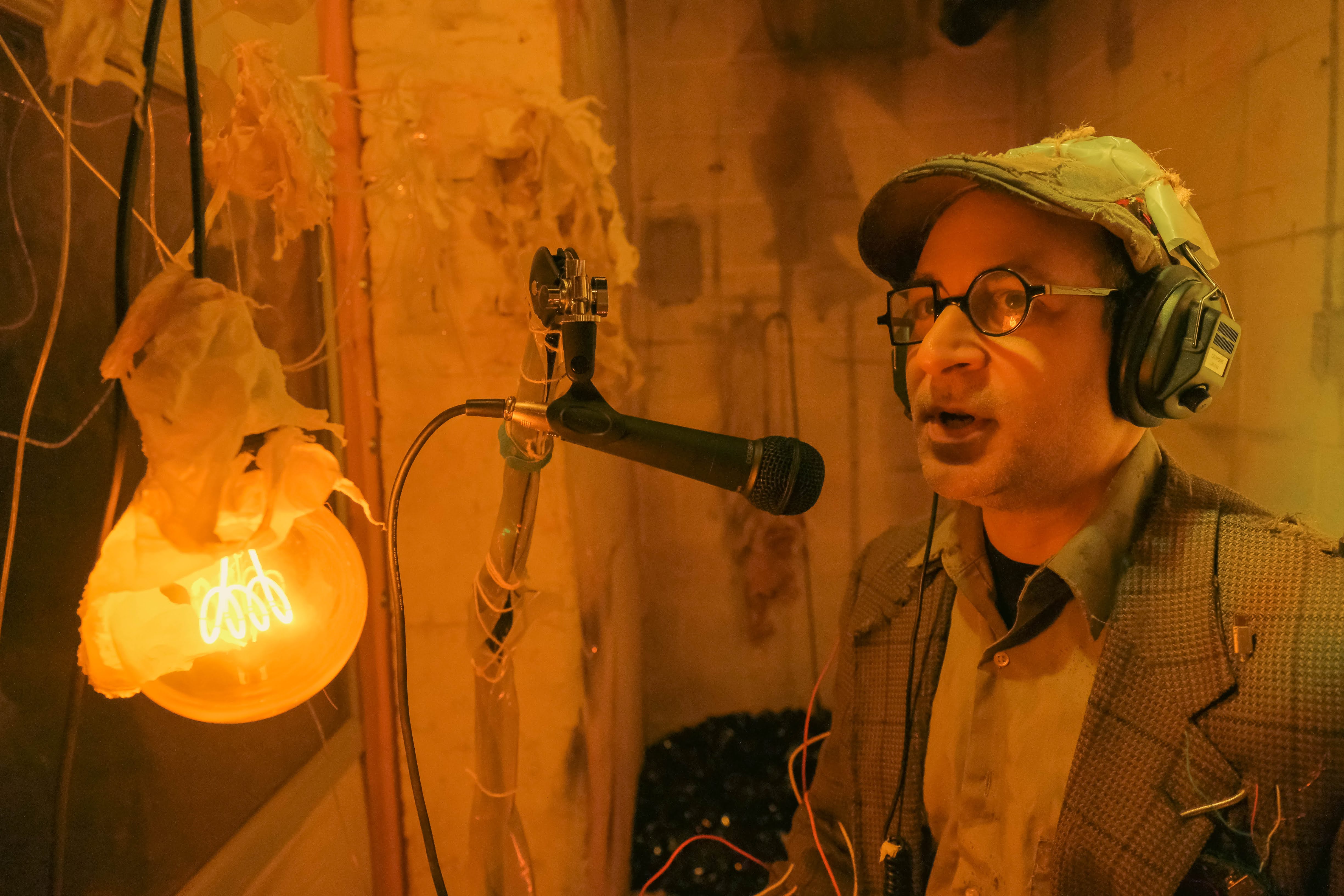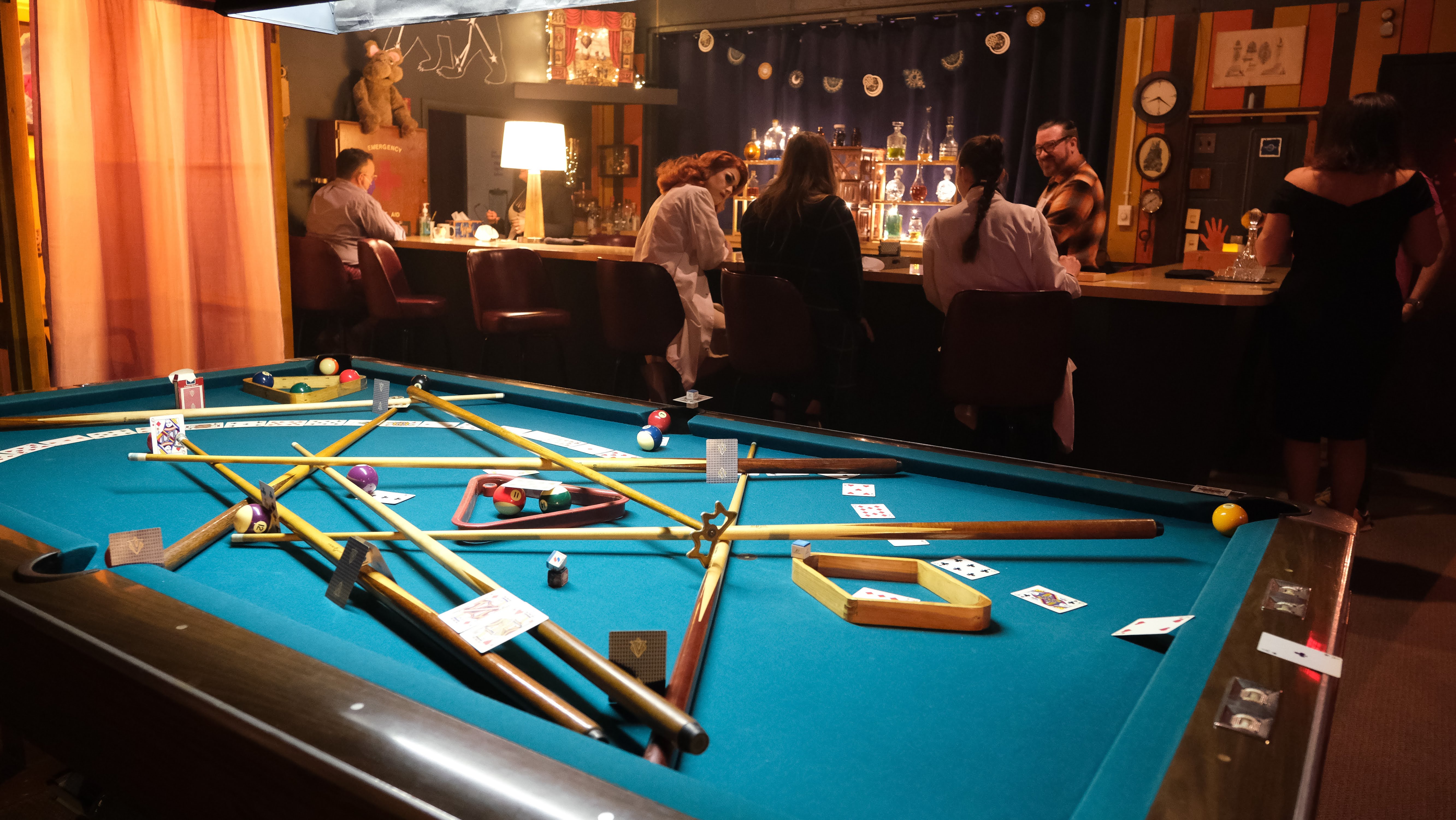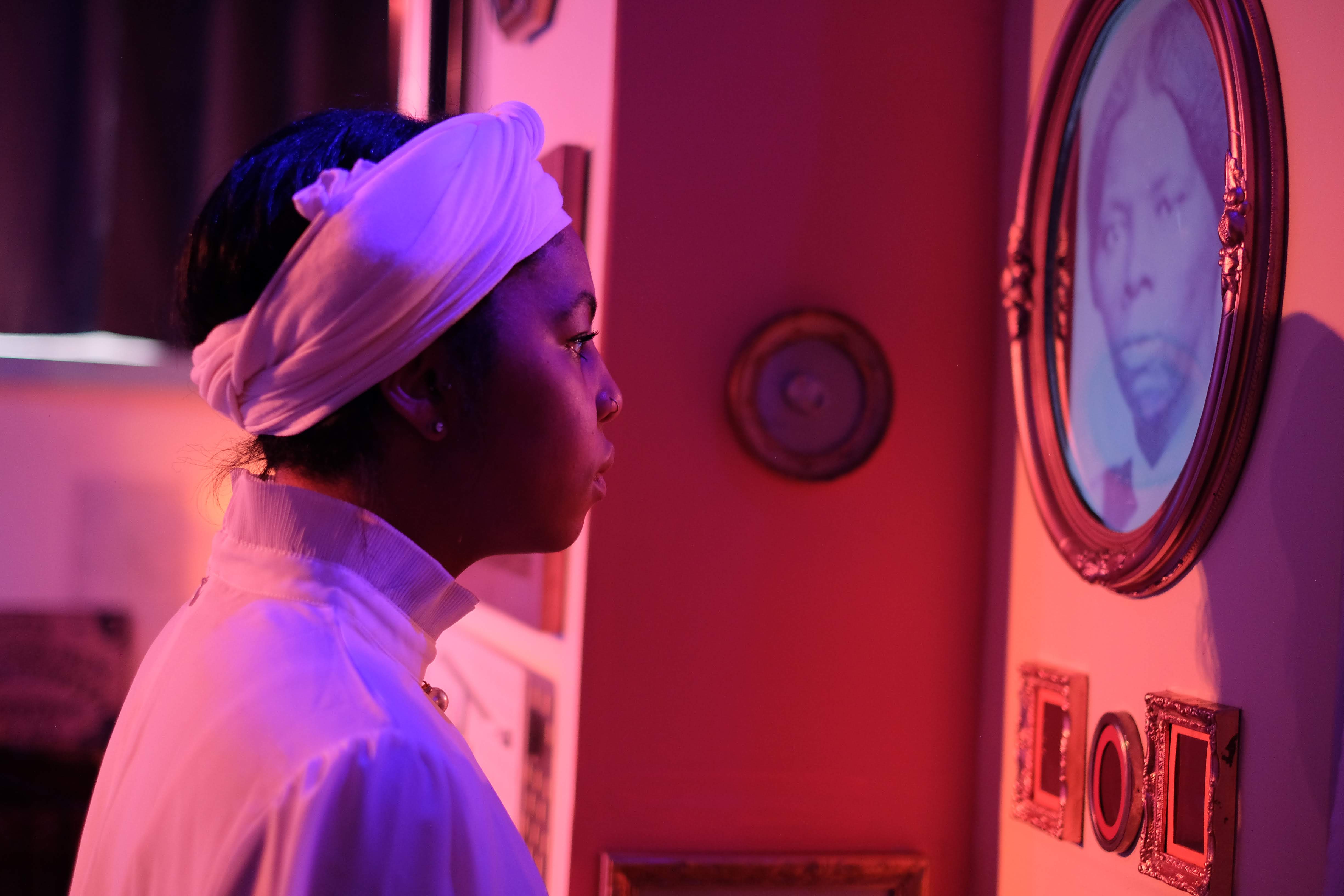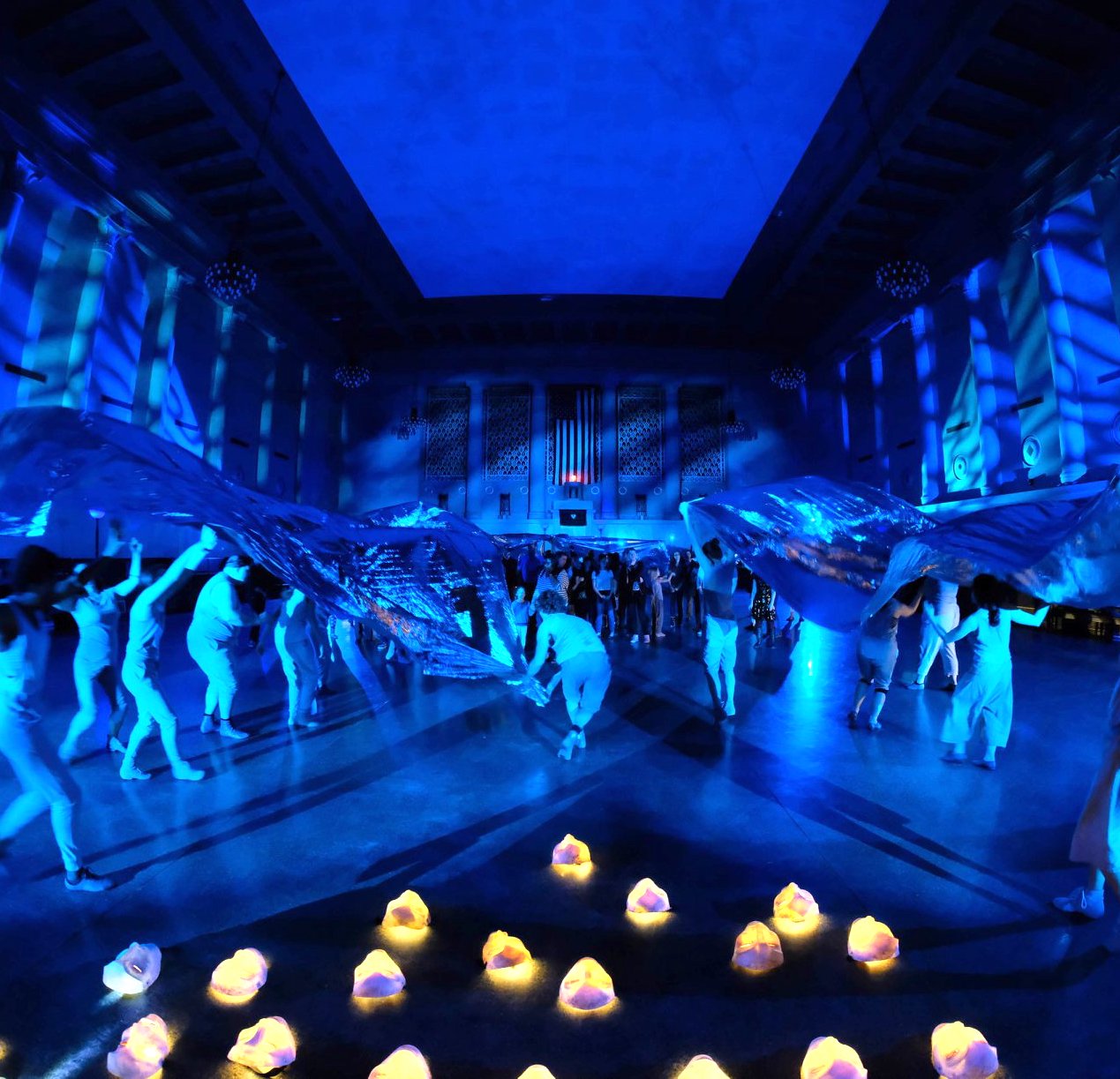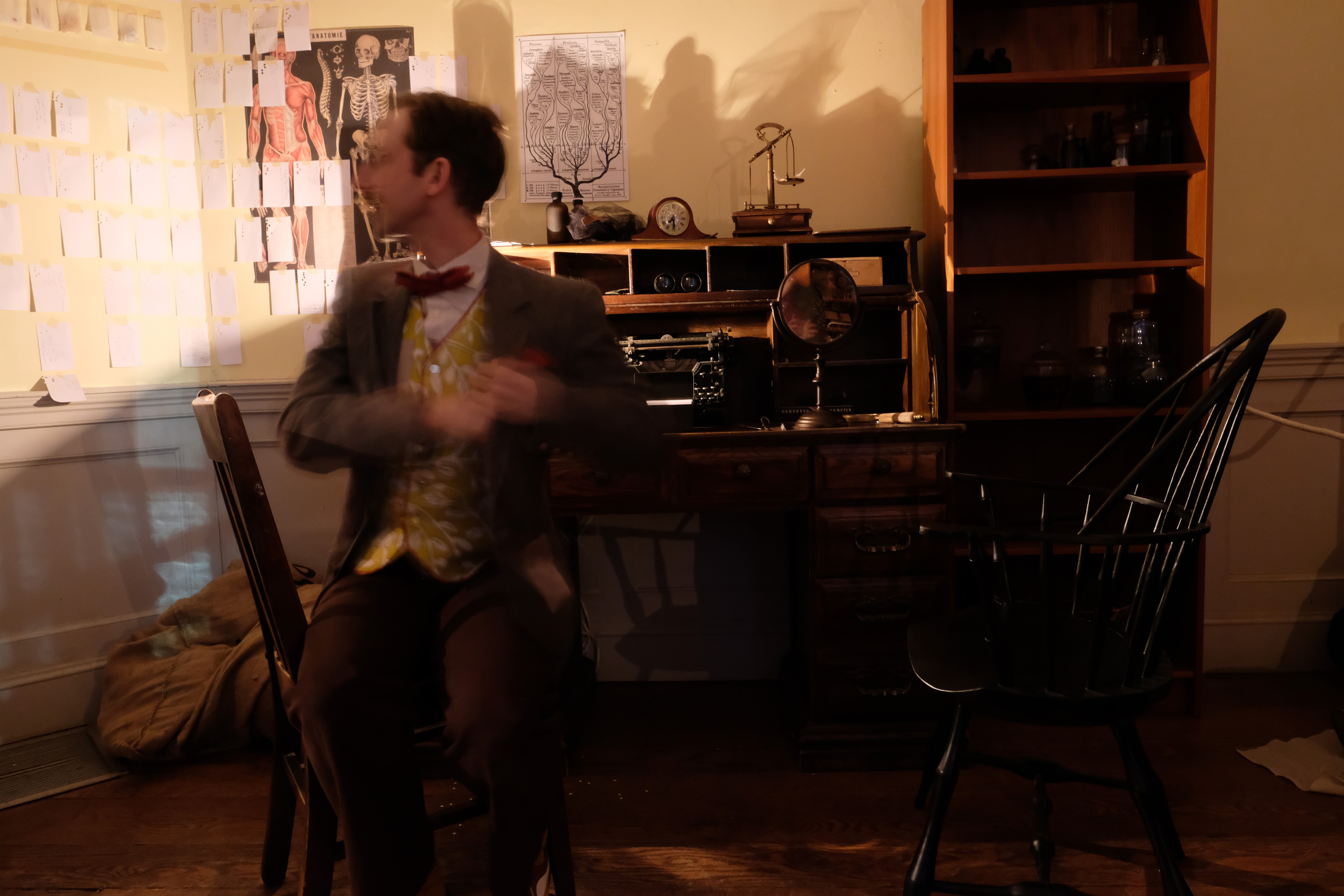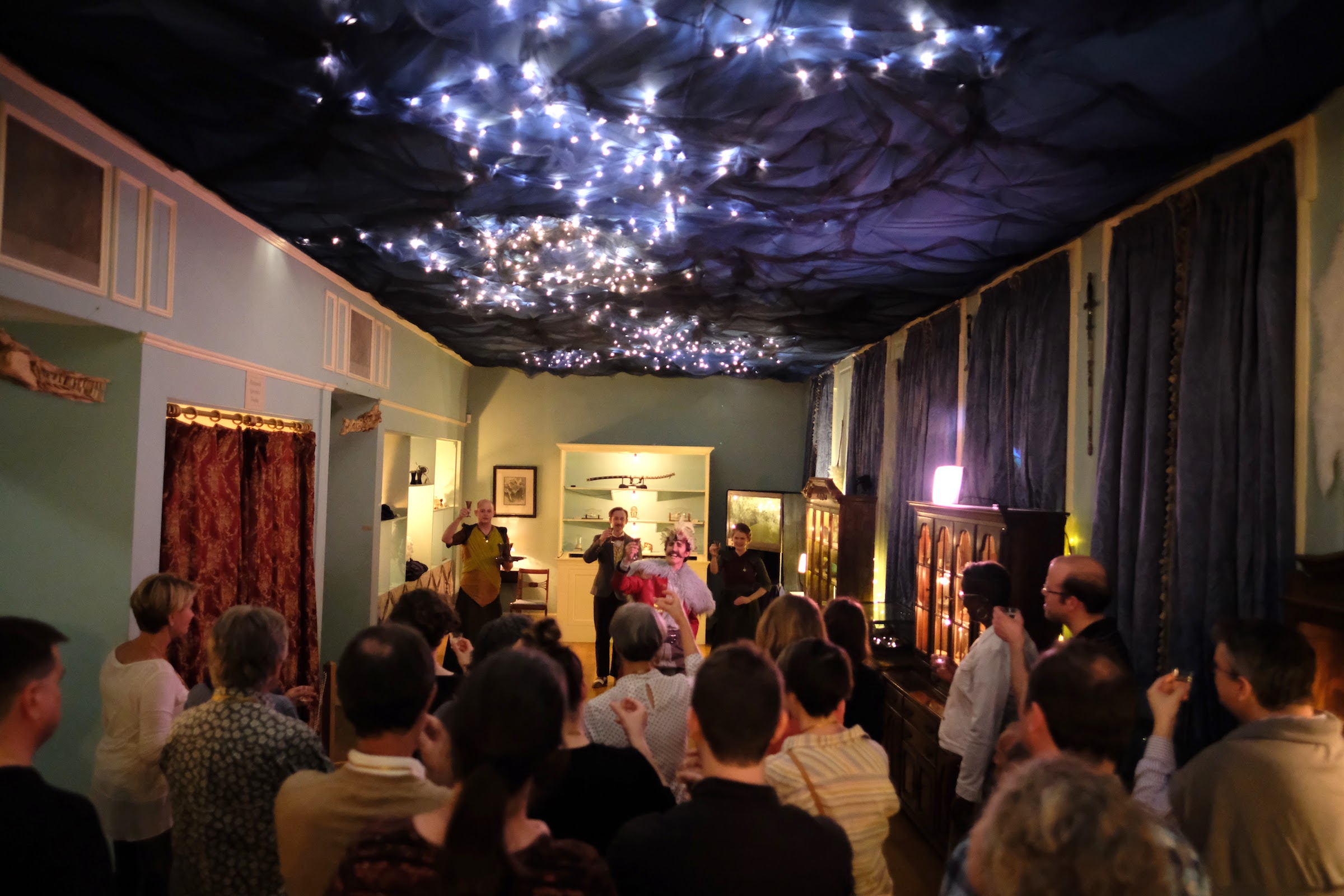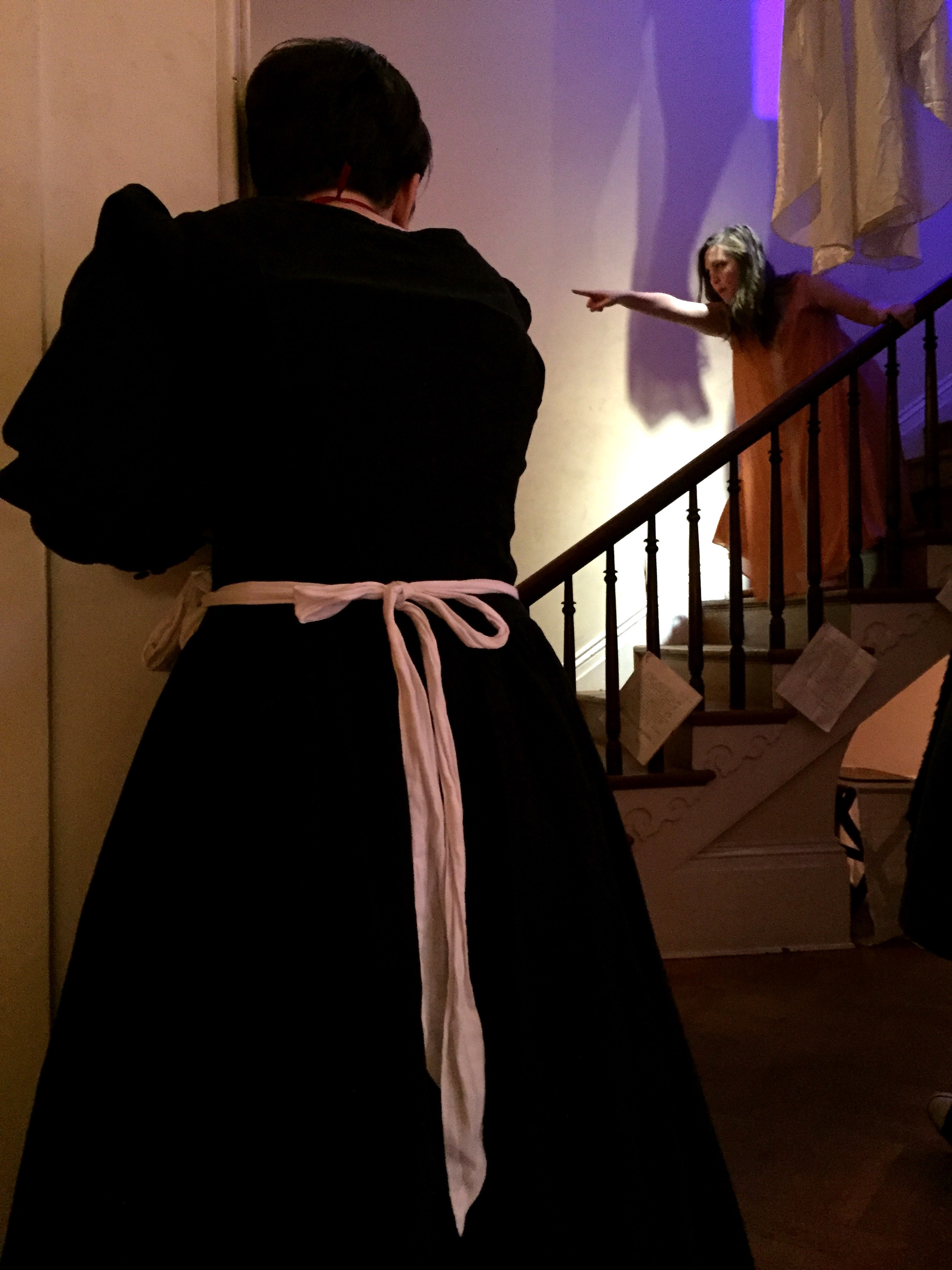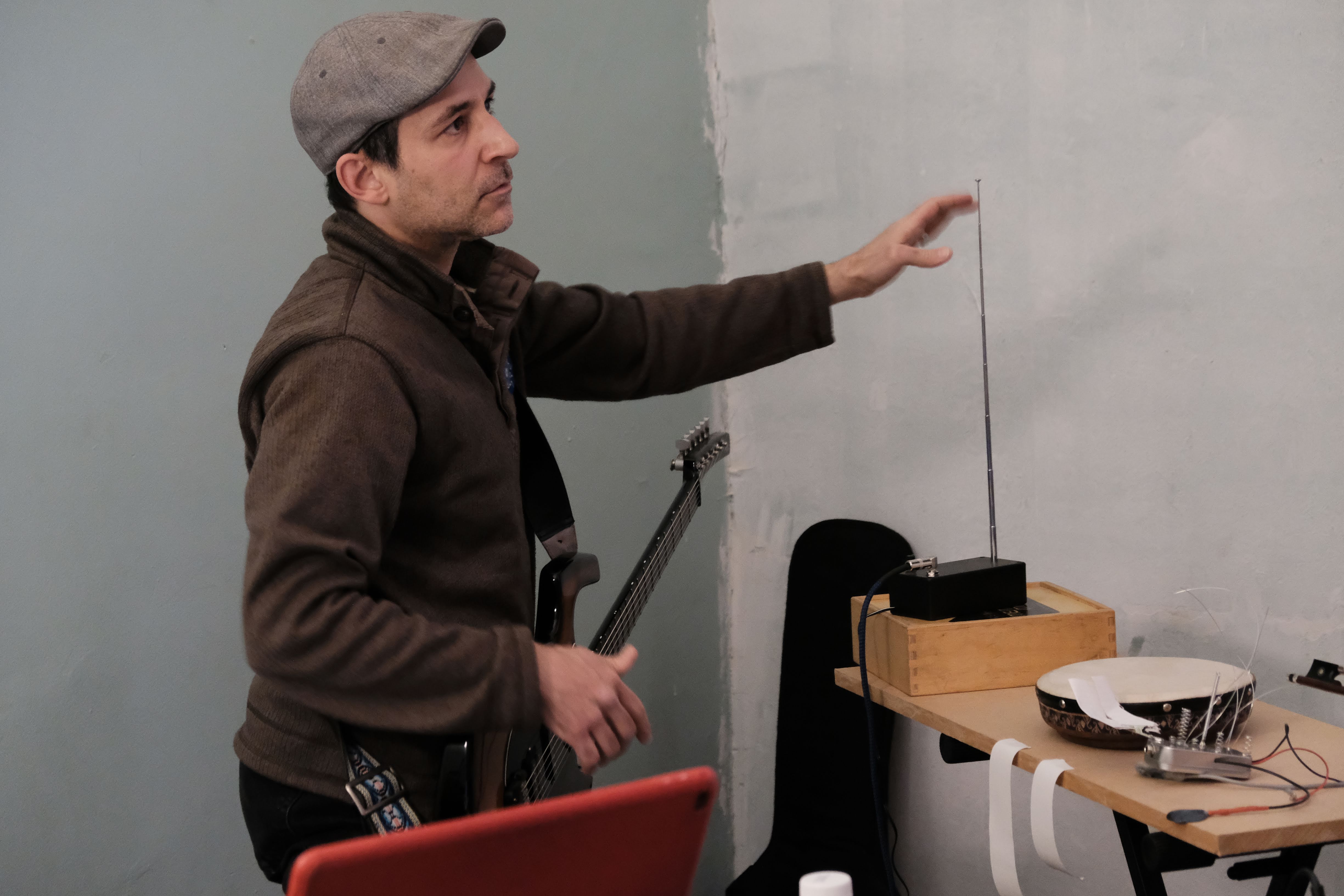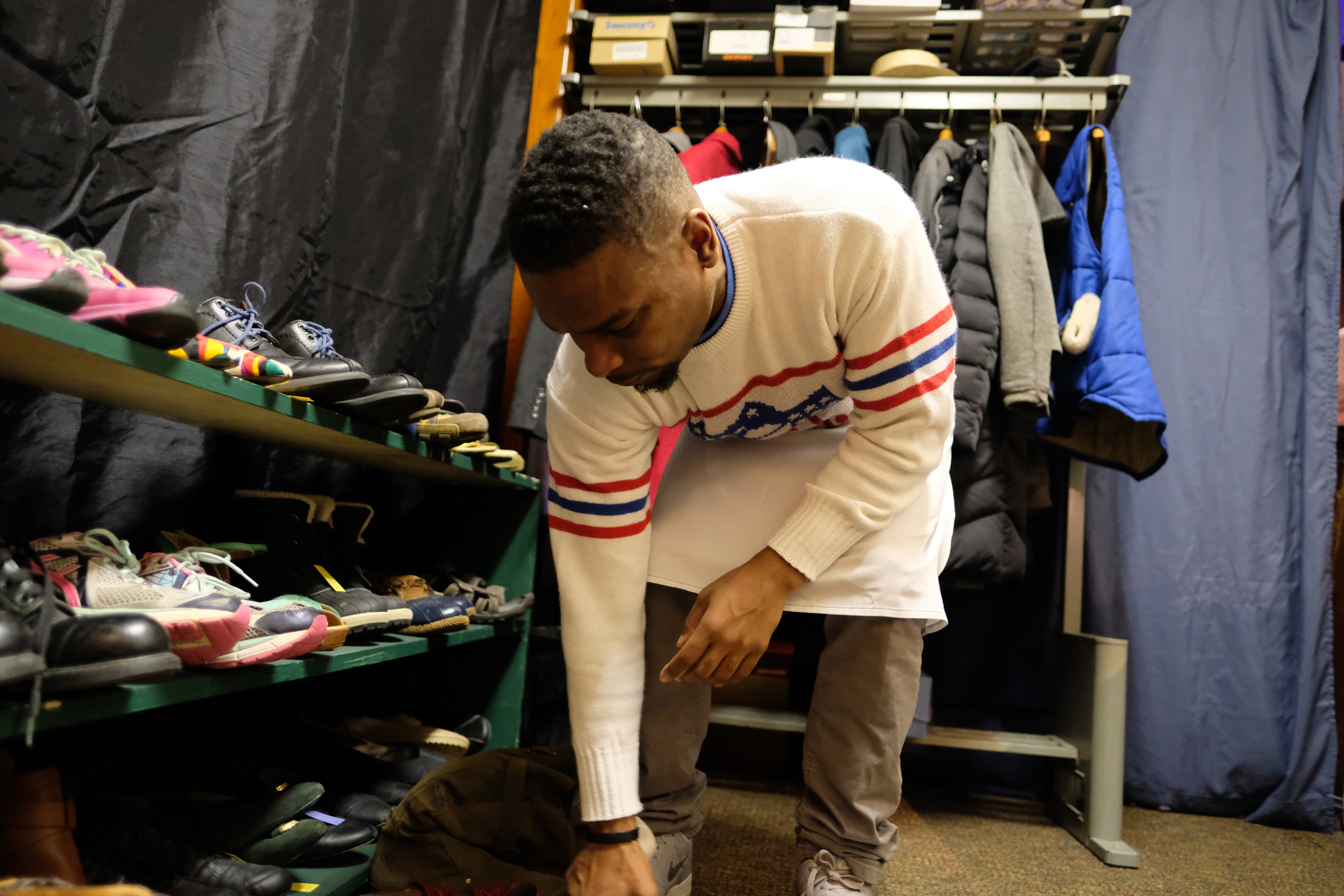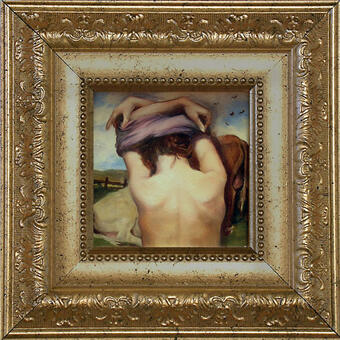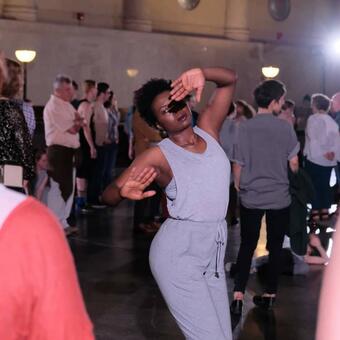Work samples
-
"See Also" - Immersive Experience at the George Peabody Library in Baltimore
-
Live Sound Design Station for "A Horse by the Tail in the Night," an 8-hour durational performance.Featured in American Theatre Magazine's special Spotlight on Sound Design: "6 Productions That Pushed the Sonic Envelope" (July/August 2019). Because the 8-hour performance was largely improvised, I needed to perform the sound accompaniment live. My live sound design setup for "A Horse by the Tail in the Night" consisted of one computer (running Ableton Live), an iPad (running two sound manipulation programs), and a DJ mixer letting me cross fade between the two. My guitar ran live through the computer, with other live instruments (theremin, microphones, and washtub bass) sent directly to the mixer. This setup left me nimble enough to switch quickly between abstract sounds of antiquity and live guitar backed up by drum beats and other software-based instruments.
-
The Mesmeric Revelations! of Edgar Allan Poe from Submersive Productions
Role: Concept, Co-producer, Co-director, Composer, Sound Designer. Devised with Ensemble. A view into the immersive experience as well as an example of my video and sound work (directed and edited by Glenn Ricci). Video footage for this trailer was shot during a single performance of "Mesmeric Revelations" with audience members wearing body-mounted cameras. All sound and music heard was also a part of the live performance.
-
The Mastodon - HT Darling's Incredible MusaeumExcerpt from HT Darling's Incredible Musaeum (Submersive Productions, 2017) Role: Co-Director (Performance) with Lisi Stoessel and Susan Stroupe. "The Mastodon Scene" is the culminating scene of the two-hour devised, immersive production of HT DARLING'S INCREDIBLE MUSAEUM. This scene was the first time all the characters and audience were in the same space, where all the narrative threads came together for the end of the narrative of the two protagonists (Trustina Sabah's Aku Maxilla/The Humanoid Specimen & Sarah Olmsted Thomas' HT Darling). Although the show did not end here, the largely wordless movement sequence was very much felt as the "climax" of the show. This scene was also the culmination of months of collaborative ensemble work; it was collaboratively choreographed, using content and research from many different parts of our process.
About Glenn
As a composer, sound designer, performer, lighting designer, and video artist, Glenn Ricci has been working with time-based media for over three decades. As a founder and Co-artistic Director of Submersive Productions, Glenn has engaged with over one hundred local artists in a unique and evolving collaborative process that melds design, performance, and world-building to create unique, impactful audience experiences.
For the past ten years, Glenn has focused on creating fully… more
Katalepsis (2023) / rECHOllection (2021)
Roles: initial concept, production, sound design, music, experience design, core creative team member. Content devised with ensemble, fabricators, and a four-member core creative team (Mika Nakano, Trustina Sabah, Susan Stroupe, and myself).
"Katalepsis is an exemplar of the gift immersive theatre can give us. It succeeds in walking a thin line: Both an engrossing escape from the everyday and art that shines a light on these recent years we’d like to forget."
-NoProscenium
"Katalepsis" invited audience members into a world set many generations into the future, when humans are no longer the dominant life form on earth. Three Creators living in total isolation have been tasked to generate creative content for mysterious Benefactors, who support their work. Relying on help from audience members, who appear to them as holobeings from the past, the characters of “Katalepsis” search for fulfillment, connection, and a way forward.
This experience ran March-May 2023 in the basement of The Peale Center, playing to over 500 people with a maximum audience size of 28 guests per run.
I initially conceived "Katalepsis" prior to the Covid-19 pandemic as a story about three "creator" characters living in isolation due to a deadly virus. It was meant to be an exploration of the many forms of social isolation we were choosing for ourselves at the time, and its cost to our mental health. Then an actual deadly virus struck and greatly changed the course of our shared story. Our "near-future" narrative moved to the very far future and, no longer having to explain what pandemic isolation might be like, we were able to take all elements of the world into more inventive directions.
The audience began their journey in the near future, when a virus that learned to jump between computers and people has wiped out most people and infrastructure on the planet. With computers becoming too dangerous to use, the Katalepsis clinic provides a way to cheat death. Drawing energy and computational power from the mycelial network (i.e. mushrooms and fungus) the clinic can created replicas of their clients' bodies that can live on without disease. The audience is transformed and wakes up some time later (perhaps centuries) and are tasked with making life bearable for the last living humans. No longer the dominant life form, the humans are kept alive by highly advanced fungal growths who move slowly through the world and affect the progress of the story in mysterious ways. Separate pathways converged at a "contribution" scene when each character presented an offering of their creative labors to the benefactors.
As with past Submersive shows, the audience could choose how much time they would spend with each character and interact to a high degree.
It may all sound rather dark, but the audience had great fun explaining aspects of our present day to curious characters living in the far future. We found much humor in imagining how future humans would interpret artifacts of the present without any context or understanding of the culture they came from.
Unable to open an immersive indoor show in 2021, the same team conceived of "rECHOllection" -- a prologue to "Katalepsis."
Concept: Due to a temporal rift next to Latrobe Pavilion in Druid Hill Park, denizens from 2032 mysteriously began to appear in our space and time. As the audience encountered them, Submersive was on hand to curate the experience.
My company's first future-fiction piece, "rECHOllection" invites audience members into the year 2032 as the earth is beginning to push back against humankind in fuller force. A virus has evolved to cross between computers and humans, rendering digital technology unusable and has greatly reduced our population. Personal and shared memories are eroding. Air and atmospheric quality make it difficult to spend time outside without full-body protection. The practice of physical distancing has only increased. And yet, through these conditions, community members of Baltimore strive to find new ways to connect, express themselves, and attempt to heal from our collective loss of memory and companionship.
The piece was our first experience to take place outside in a public park, with no tickets, restrictions, or gateways preventing audience members from entering. Not only did the outdoor venue contribute to audience safety during a pandemic, it allowed the audience to interact and respond in open and unexpected ways. Acknowledging that interactive, immersive experiences can always feel a little awkward, the experience reflected the extent that we are all in an awkward, in-between place when it comes to being out in public and interacting with people. The resulting experience seemed to meet the audience where they were and resonate with the very moment we all are sharing in.
-
 DJ Horatio Arugula
DJ Horatio ArugulaRadios throughout the set were tuned to the same station, which was broadcasted live from a DJ booth, where the audience could enter and interact with the resident DJ. Performers Francisco Benavides and Bao Nguyen created two very different versions of the DJ, giving audiences a different perspective depending which show they attended.
Due to a fluke in the performance schedule, neither performer could be present for one Sunday late in the run. After the show opened, I spent the better part of a month learning the role and developing my own script for it. For one show, I performed what was a very strange talk show hosted by DJ Horatio Arugula. Neither man nor mycelia, I had been brought to life at the very start of the show and was doing my best to report the truth about what I knew and attempt to make sense of our visitors from the far past and their strange ways.
Photo: Francisco Benavides
-
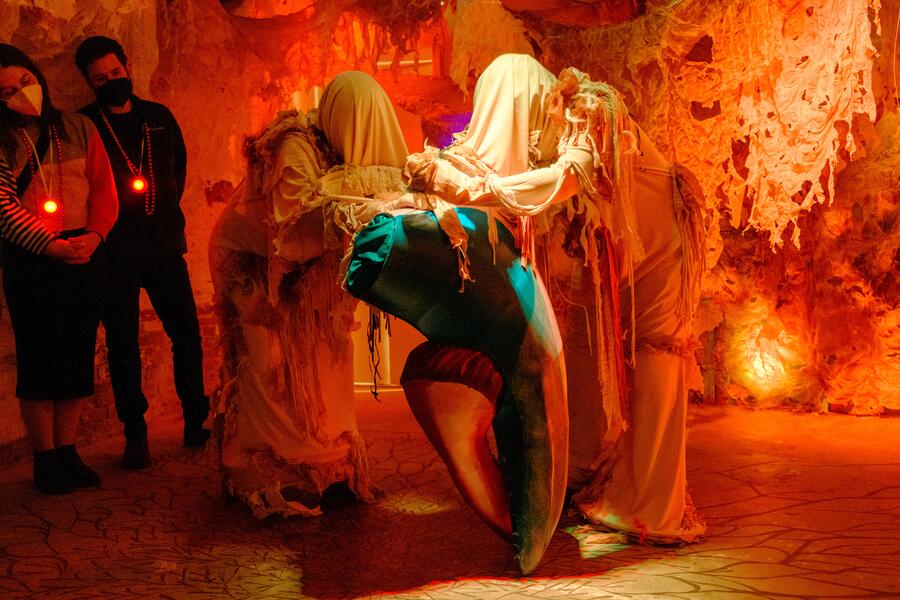 Mycelial "Benefactors" Prepare for the Contributions Ritual
Mycelial "Benefactors" Prepare for the Contributions Ritual -
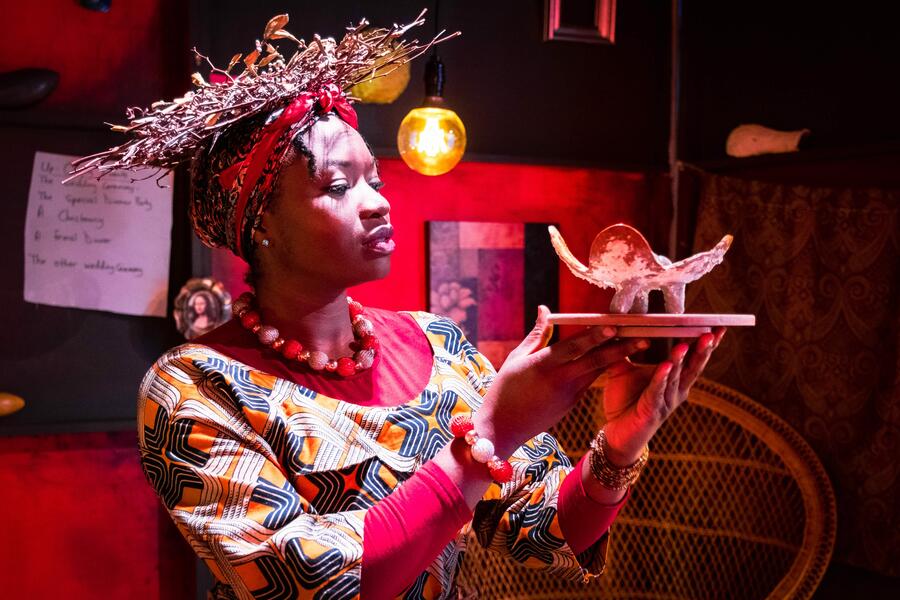 Trustina Fafa Sabah as "Madame"
Trustina Fafa Sabah as "Madame"Trustina Fafa Sabah (also a member of the production's Core Team) devised Madam as a merchant attempting to share past traditions in a world that no longer had a shared culture to sustain them. Sabah incorporated her own gourd artworks into the set and created audience activities around partially mis-remembered past traditions.
-
 Timekeeper
TimekeeperAlternately known as The Weaver, Hannah Fenster devised "Timekeeper" as a creator recording stories and the passage of time into fabric. She would prompt the audience for stories and thoughts that would weave into her perpetually unfinished masterwork.
-
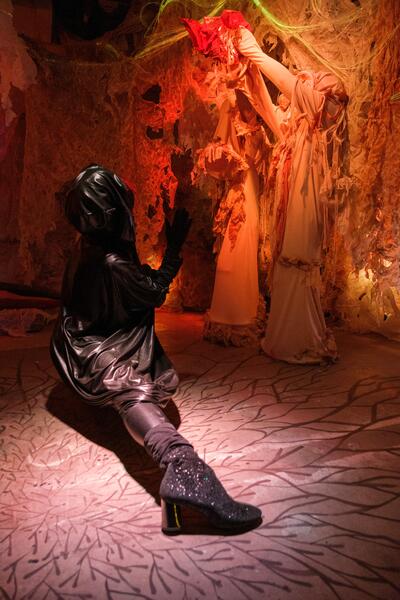 The Contributions Ritual
The Contributions RitualThe "Contributions" scene was one moment late in the show when all characters and audience converge. Each Creator, donning a "sack suit" to protect themselves from the infectious air outside their rooms, would offer the fruits of their creative labors to the mycelial Benefactors. Each character had a different perspective on this ritual, what it meant for them, and what they made of the results.
-
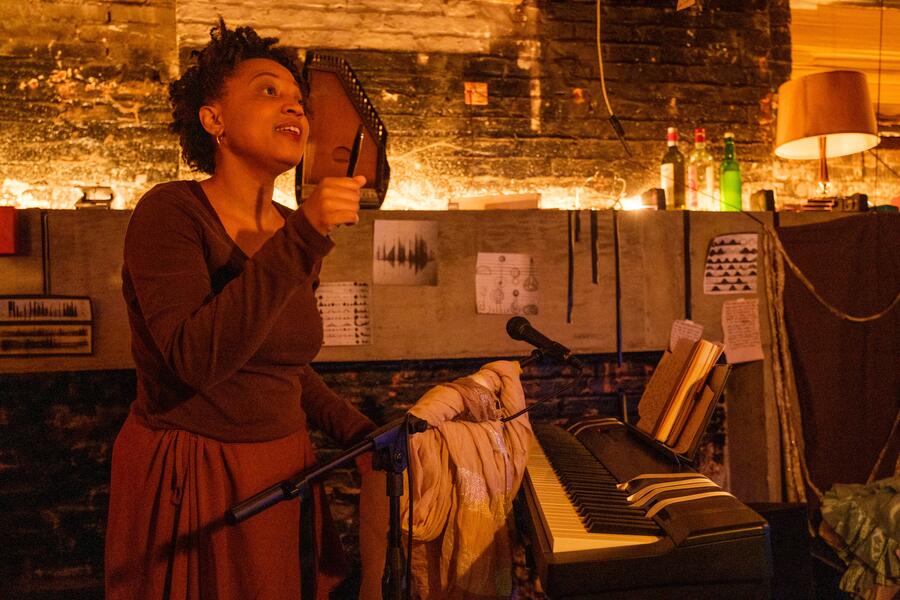 Megan Livingston as "Pheonix"
Megan Livingston as "Pheonix"Devised by Megan Livingston, Pheonix's narrative arc centered around her struggle to write the perfect song. She engaged the audience in various forms of music making and questioned them on the meaning of love and connection.
-
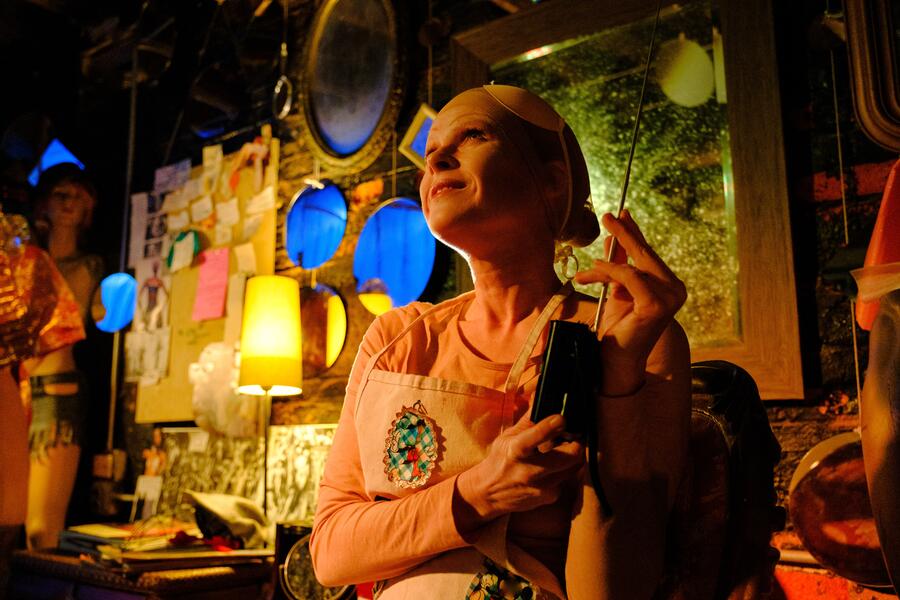 Lisi Stoessel as "Strata"
Lisi Stoessel as "Strata"One of four "Creator" characters, Strata (devised and performed by Lisi Stoessel) is obsessed with fashion and status. Living in a future time when there is no culture to sustain the idea of "fashion," she relied on audience members knowledge of the past and consulted them on her decisions. Her room contained nearly our entire wardrobe stock as functional scenery.
-
Recollecting "rECHOllection"
Documentary film about "rECHOllection" by Steven Zhu.
-
The "Sack Suits" and a giant crab claw
In the backstory for rECHOllection, in 2032 it becomes too dangerous to go outside without full-body protection from the sun and air. The standard one-size-fits-most protective suits (created by Deana Brill) are so depersonalizing that individuals decide to augment them with their own modifications. With the loss of digital technology and social media, suit augmentations and other attempts to "hack" the suit, create a new kind of avatar. We had a giant crab claw fabricated (by artist Alexandra Ciardullo) as one suit modification and worked with the performer (Jacob Zabawa) to give it meaning and make it a part of a daily routine that acknowledged the people and past connections they had lost. Both the sack suits and crab claw re-appeared in "Katalepsis."
-
Mother and daughter
rECHOllection featured a dozen performers, including a mother and daughter team (Tara Cariaso and Nadya Elson) who each interacted with the audience in their own way. Working with the the limitations of the "sack suits" and a mostly wordless performance challenged each performer to find unique ways to engage and express themselves.
The Boundary (2023)
Roles: production, lighting design, sound design (with Megan Livingston), music, core creative team. Content devised with ensemble and core creative team (Josh Aterovis, Kim Le, Megan Livingston, Ursula Marcum, and myself).
The concept: Visit Boundry, a brand-new startup that allows you to pre-plan and customize your afterlifeexperience. As part of our exclusive market research team, tour our state-of-the-art facilities andafterlife showroom. For every door that closes, another will open.
Over 600 guests experienced "The Boundary" from September-November, 2023. Audience entered in groups of up to eight people each half-hour, with four groups each night.
"The Boundary" began with an idea by core team member Kim Le, who wanted to create an experience that helped people better orient themselves with the idea of death and the afterlife. In 2020, as we were losing friends and family members to a deadly pandemic, the topic of death still felt strangely detached from our day to day lives.
The audience's journey began in Boundry Labs where a lab attendant led them in a conversation about death and the afterlife. They were then free to explore the Afterlife Showroom, which contained about a dozen explorable installations. After some time, audience members were invited to join a "focus group" where they are accidentally ushered through a rift that transitions them to their own afterlife. Fortunately, the beings on the other side are able to offer a way back. In the meantime, we provided a number of ways to contemplate their own death and leave messages for those who crossed over before them. Many audience members reported that the experience gave them a deep shift in perspective and they have been contemplating it ever since.
The experience was included on a national list of "Best Immersive Moments of 2023"
-
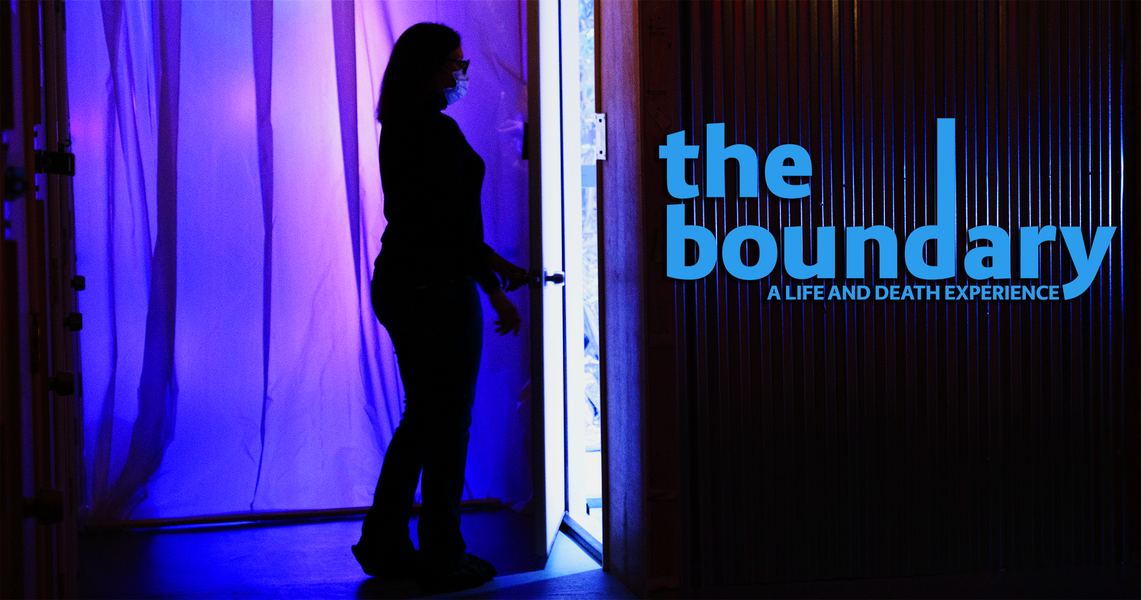 "The Boundary" title graphic
"The Boundary" title graphicTitle graphic for the "The Boundary." Word mark treatment by Josh Aterovis, photo taken during our initial test run.
-
 Bar Do
Bar DoThe final stop on the audience's journey: Bar Dō. There, each guest has a one-to-one interaction with a bartender and a doctor character who give them a custom prescription for their return back to life. My role each night was that of "DJ Jüs" who played for each guest one of their favorite songs just as they entered the bar. (Many had forgotten 90 minutes prior that we asked them to tell us a song that made them happy.) Filtered through a series of effects, their song was woven into an etherial soundscape while still striking a very personal emotional tone.
-
 Boundry Labs Afterlife Showroom
Boundry Labs Afterlife ShowroomFor about 30 minutes of the experience, guests were free to explore the Afterlife Showroom, where a series of plainly labelled doors each held behind them very different installations. With the lighting, I wanted to strike a balance between sterile lab and a tech startup who were trying to present their playful side. The sound in the hallways was a gentle cacophony from the various rooms, plus additional sounds to make the lab seem even more active.
-
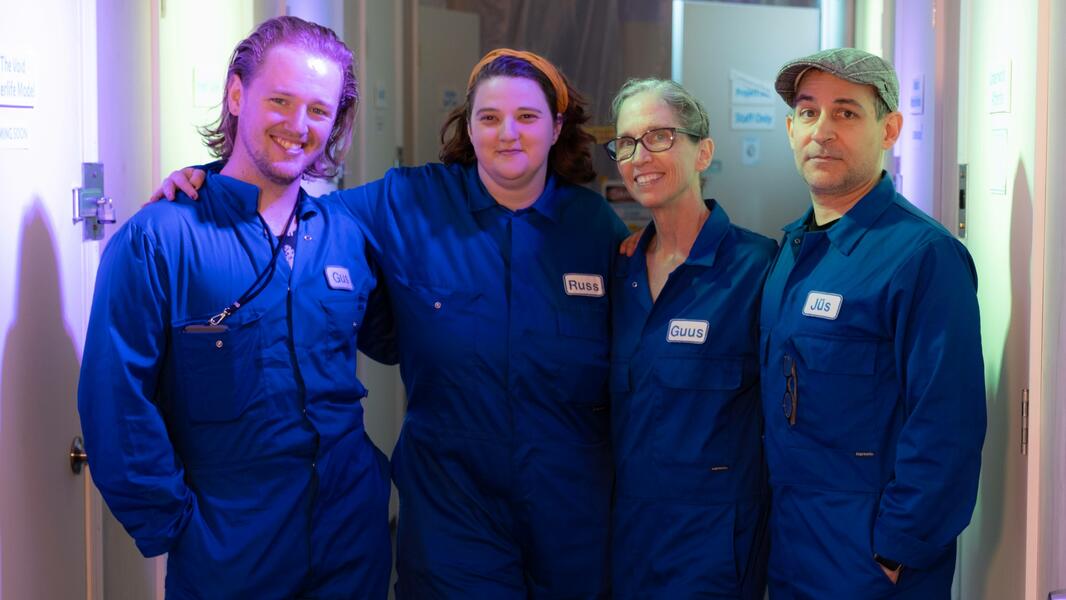 Boundary Production Team
Boundary Production TeamMe (far right) with the rest of the Boundary production team: (left to right) Griffin Delisle, Mara Fabro Wild, and Ursula Marcum. Each audience member needed to be tracked individually for us to be able to personalize their experience. We remained in costume and in view of the audience, who would sometimes interact with us and ask questions about the world.
-
Boundary Theme
On a whim, I composed this "theme song" for the project and the team thought it fit the mood so well that we should work it into the show. A longer version of the the track played as the audience waited in the lobby.
-
Your Energy Afterlife
Within this highly collaborative artwork was one installation I can call my own. Behind a door labelled "Energy Afterlife" was bench seated in front of a plant that, when touched by the audience, would activate a live, dynamic sound and light projection. The concept was meant to illustrate, in a literal way, what happens to our energy after we die.
-
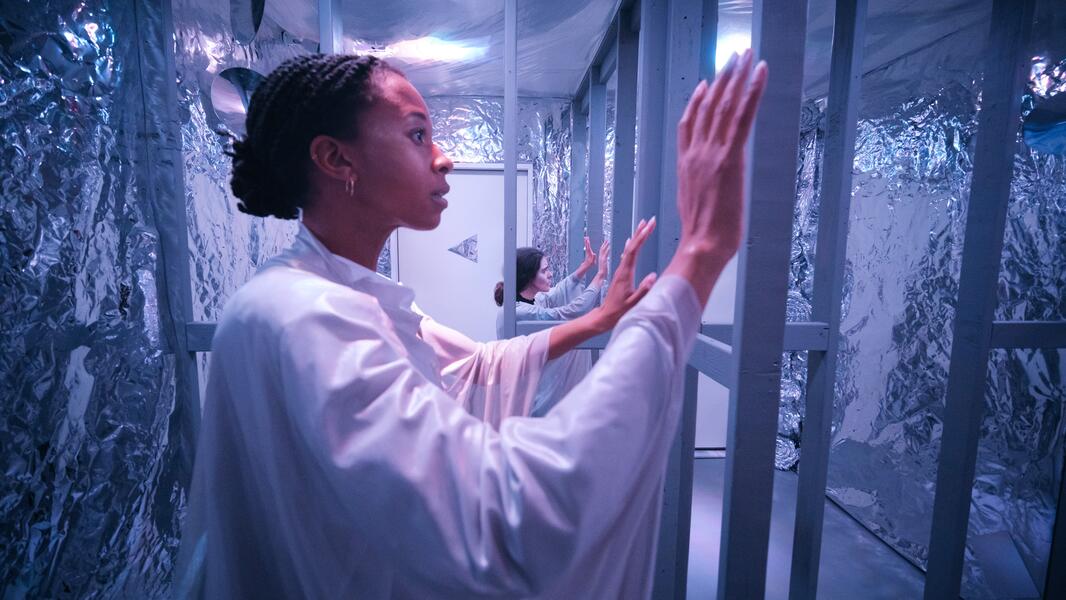 The Mirrorless Mirror Room
The Mirrorless Mirror RoomAfter touring the lab, each guest is invited to join a focus group in a conference. What they discover instead are two lab employees suspended between worlds, unable to speak. We called the room the "Mirrorless Mirror room" because the wooden skeletal structure of space created an illusory mirror effect. I added a "Shephard Tone" soundtrack to increase the unsettling feeling of passing through a rift.
See Also (2020)
Roles: production, lighting design, sound design, music, experience design, core creative team. Content devised with ensemble and core creative team.
"See Also" was a devised, site-specific, immersive experience that was run as a part of the "In the Stacks" series held at the George Peabody Library, in Baltimore, in February of 2020. Following threads (both figurative and literal) around the Peabody Library in a choose-your-own-adventure style, participants encountered visual art, soundscapes, and performers portraying character composites based on historical women and non-binary individuals from the collections of the Johns Hopkins Sheridan Libraries and University Museums.
The performance culminated in the world premiere of a work by contemporary female composer Briay Conditt. For the eight-channel soundtrack, I provided sound design, additional music, and coordinated the long-distance collaboration for Ms. Conditt's composition.
This highly collaborative work was developed with a large cast and a Core Creative Team of nine members.
-
 Opening Sequence
Opening SequenceOnce the audience is settled in the space, the lights click off one level at a time to reveal each of the Character Composites. Yellow threads traveled upwards around the space to connect them with the ideas, history, and people below. The Composites descend to join the Seekers (those using the library) and the rest of the audience.
Photo: Photos by Kintz
-
"See Also" - Immersive Experience at the George Peabody Library in Baltimore
-
See Also Soundtrack ExcerptThe eight-channel recording that covered the whole lower level of the Peabody Library is mixed down to two channels (i.e. stereo) so you can also enjoy it here. This music and soundscape bridges the time between the introduction of the audience to the space, the first major sequence of the show, and the arrival of all the characters to their respective spaces.
-
Multiple Storylines, Perspectives, Layers of Exploration
It was important to me that each audience member would be able to explore, discover, and construct their own narrative from the many layers of simultaneous action around them. Lighting each alcove with a different color helped indicate that something new was to be found in each space.
-
 Introducing the Cartographer
Introducing the CartographerIn the opening sequence, the house lights dimmed to reveal the "Character Composites" each in their own illuminated nook Moments throughout the experience were designed to encourage the audience to gaze upwards and engage with the wondrous height of the room. The Cartographer (performed and devised by Hannah Fenster) was inspired by Shanawdithit and Judith Tyner.
Photo: Photos by Kintz
-
Born from the Mud/NaturalistKey among my early planning ideas was to use the vestibules around the center space to highlight each Character Composite. I designed the lighting to set them off as separate environments, each in their own color, where audience members can focus on the interactions specific to that character. Born from the Mud/Naturalist, performed and devised by Mika Nakano, was inspired by Laura Bassi, Eunice Newton Foote, Hedy Lamarr, and Maria Sybilla Merian.
-
 Electronic Music PioneerThe Electronic Music Pioneer (performed by and devised in collaboration with Natanya Sheva Washer) was a character composite inspired by Wendy Carlos, Jean Eichelberger Ivey, Pauline Oliveros, and Daphne Oram. The character led audience members through a guided meditation, creating a live headphone soundscape using synthesizers and vocal loops.
Electronic Music PioneerThe Electronic Music Pioneer (performed by and devised in collaboration with Natanya Sheva Washer) was a character composite inspired by Wendy Carlos, Jean Eichelberger Ivey, Pauline Oliveros, and Daphne Oram. The character led audience members through a guided meditation, creating a live headphone soundscape using synthesizers and vocal loops. -
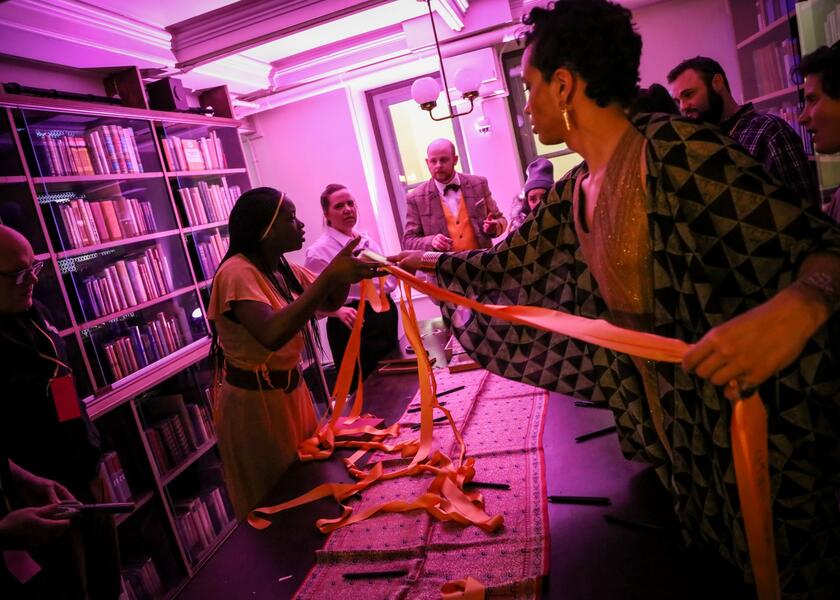 Close interactions
Close interactionsAnother key aspect of the experience design was to maintain a five-to-one ratio of audience to performer so that everyone had an opportunity for several close (sometimes even one-to-one) interactions with the show's many characters. Each interaction was devised and rehearsed with great care to involve the audience in meaningful ways while fitting with the theme and tone of the show's world. Those who attended more than once (which they could do in the same evening) were able to have a very different experience each time.
Photo: Photos by Kintz
-
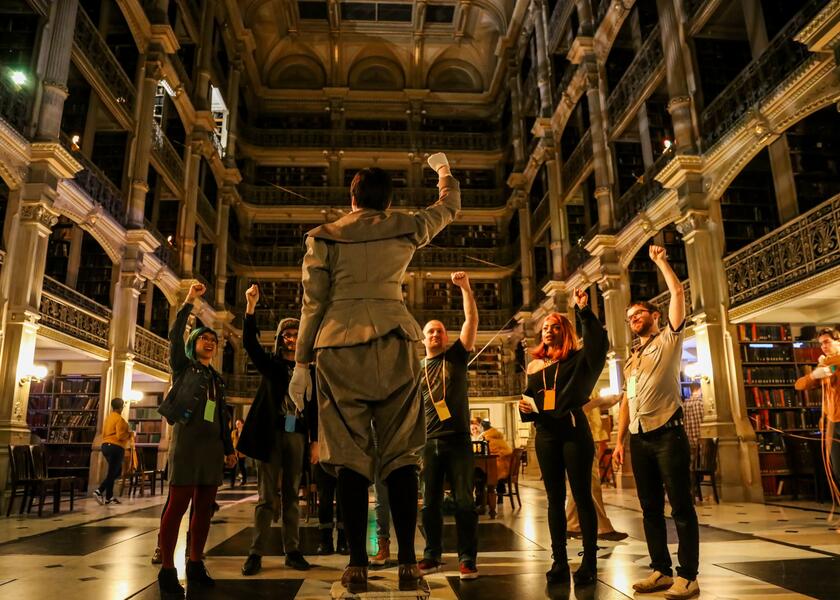 Revolutionary/Suffragist/Activist
Revolutionary/Suffragist/ActivistThe Revolutionary/Suffragist/Activist enticed audience members into a miniature rally and led them in a march around the space. Performed and devised by Jess Rassp, the character was inspired by Frances Ellen Watkins Harper, Edith Houghton Hooker, Dr. Mary Edwards Walker, Dr. Lilian Welsh, Yaa Asantewaa, and Ruth Bader Ginsberg.
Photo: Photos by Kintz
-
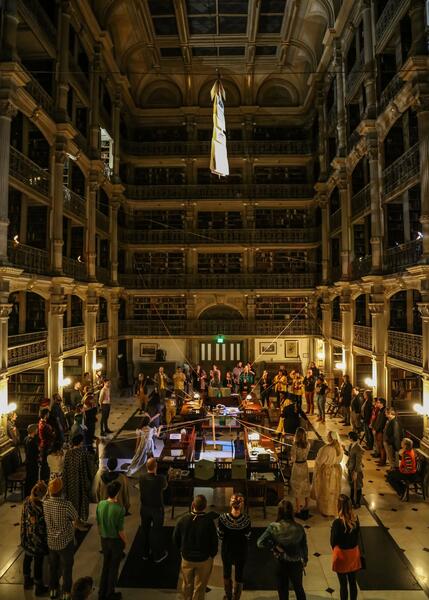 The Culmination
The CulminationThe Culmination was the final scene, when all characters, storylines, and the audience converged to create a unique sculpture out of the cultural artifacts uncovered throughout the experience.
Photo: Photos by Kintz
The Institute of Visionary History and the Archives of the Deep Now (2018-2019)
Initial run throughout Fall 2018, remounted in Summer 2019.
I conceived "The Institute" with my wife and Co-artistic Director, Ursula Marcum, to be a broad platform for experiential performance and audience discovery. As the story goes... Discovered in the basement beneath The Peale Center, the Archives of the Deep Now are the records of a centuries-old secret society calling themselves The Institute of Visionary History. The Institute believed the building to be a kind of “thin place” where one can more easily transcend our present reality and contact other planes, places, and times. Submersive created The Archives from instructions left behind by The Institute of Visionary History before they mysteriously vanished in 1997. Each box from The Archives contains an experiment designed to conjure visions of the past in order to ask a specific question. Each resulting "episode" is a stand-alone, fully immersive experience for an audience of up to five people at a time. With an elaborate backstory slowing being revealed over time, and individual episodes exploring American history and identity, “The Institute” has become a vehicle for personal, intimate storytelling experiences. So far, we have created six episodes total, each using the space in very different ways. To create each episode, we chose to partner with performers to develop stories originating from outside of our daily lived experience. This collaboration helped us develop a unique voice and create space for identities that are not typically placed in the center of a theatrical narrative.
-
Project P.S. immersive theatre experience (Official Teaser Trailer)An episode from "The Institute of Visionary History and Archives of the Deep Now" Roles: Series Concept, production, core creative team member, lighting, sound, music, projections, room design. Content devised with ensemble and core creative team. For video: camera, editing, music by Glenn Ricci. Performed by Mika Nakano. Created for "Project P.S." as it was re-visioned and re-mounted in Summer of 2019, using the set of The Institute of Visionary History. The experience included original projections and a newly composed 20-minute synthesizer soundtrack, some of which can be heard in this trailer.
-
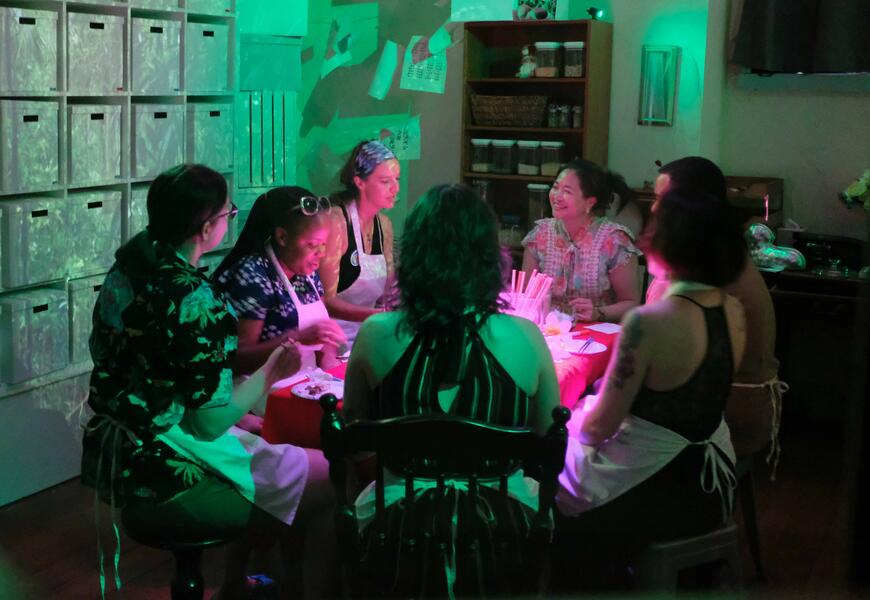 "Altar Ego"In "Altar Ego" (Fall 2018, Remounted Summer 2019), Kim Le leads a Vietnamese Mourning Ritual with several surreal suprises. The "Archive Wall" (left) contains a set of 25 boxes, each containing the start of an experiment. The wall also serves as a flexible projection surface, serving a different purpose in each episode. Seen here in "Altar Ego," the wall transforms into a jungle during a moment of silence for the ghosts at the table.
"Altar Ego"In "Altar Ego" (Fall 2018, Remounted Summer 2019), Kim Le leads a Vietnamese Mourning Ritual with several surreal suprises. The "Archive Wall" (left) contains a set of 25 boxes, each containing the start of an experiment. The wall also serves as a flexible projection surface, serving a different purpose in each episode. Seen here in "Altar Ego," the wall transforms into a jungle during a moment of silence for the ghosts at the table. -
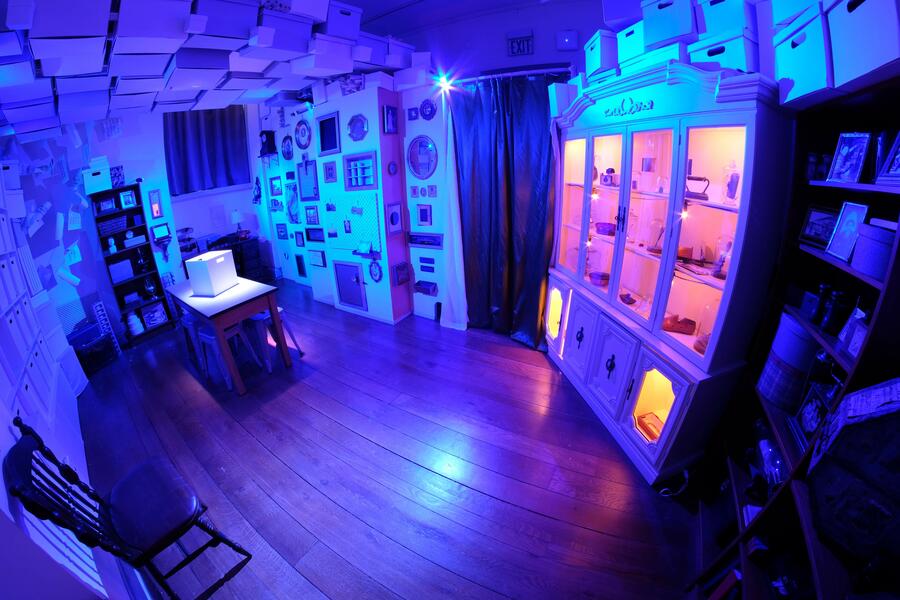 The Archives of the Deep NowThe Archives of the Deep Now was designed to be and intimate space, but detailed enough that it would be difficult to take it all in in one visit. We describe the room as a kind of machine designed to access the "thin place" where this world and others connect.
The Archives of the Deep NowThe Archives of the Deep Now was designed to be and intimate space, but detailed enough that it would be difficult to take it all in in one visit. We describe the room as a kind of machine designed to access the "thin place" where this world and others connect. -
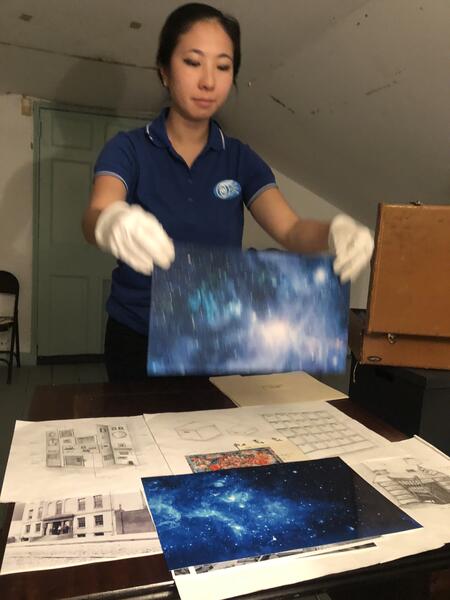 Induction Into the InstituteAll would-be researchers in the Institute are put through an induction ceremony. There, they are told about the past and underlying principles of The Institute as well as given information about the particular experiment they are about to undertake. Pictured here, Mika Nakano provides visuals and gestures in sync with a voiceover narration before swearing in a new group of inductees.
Induction Into the InstituteAll would-be researchers in the Institute are put through an induction ceremony. There, they are told about the past and underlying principles of The Institute as well as given information about the particular experiment they are about to undertake. Pictured here, Mika Nakano provides visuals and gestures in sync with a voiceover narration before swearing in a new group of inductees. -
 Portrait MirrorOne feature of the "Mod Wall" is a portrait mirror that transforms from the reflection of the viewer to other imagery. Pictured here in Episode One, Harriet Tubman (Rachel Reckling) gazes into a series of historical portraits and wonders why she finds it so difficult to recognize herself.
Portrait MirrorOne feature of the "Mod Wall" is a portrait mirror that transforms from the reflection of the viewer to other imagery. Pictured here in Episode One, Harriet Tubman (Rachel Reckling) gazes into a series of historical portraits and wonders why she finds it so difficult to recognize herself. -
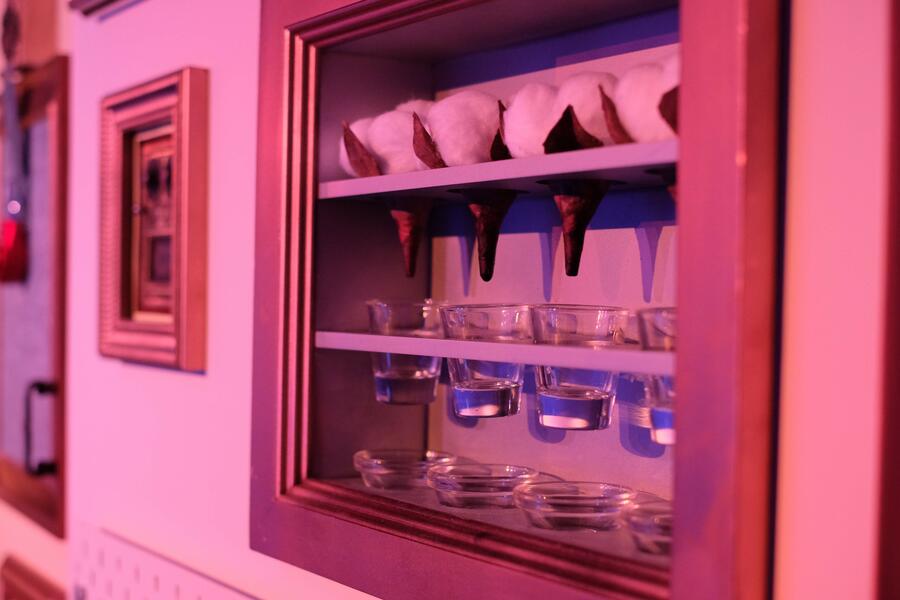 Mod Wall ModificationsFor each episode, the "Mod Wall" contains different objects and imagery. In a moment of of striking surrealism in Episode One, each shot glass gets filled with wine as Harriet squeezes the cotton ball above each one.
Mod Wall ModificationsFor each episode, the "Mod Wall" contains different objects and imagery. In a moment of of striking surrealism in Episode One, each shot glass gets filled with wine as Harriet squeezes the cotton ball above each one. -
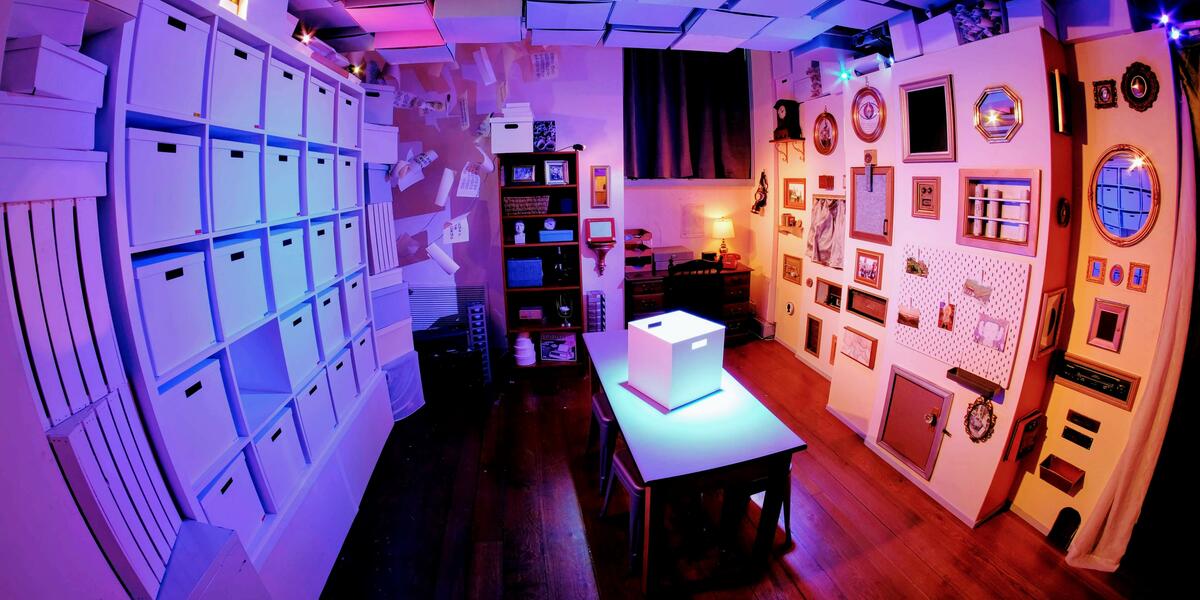 The Mod WallOpposite the Archive Wall (boxes on left) is what we call the "Mod Wall" (right). The modular design is meant to be flexible and responsive, changing and responding to the action depending on the story being told. Full of nooks and tangible objects, we treat the wall as a giant puppet that has a character all its own. The audience and characters alike can discover objects and tools in the wall that help spur their story along. Through various forms of communication, the wall can also provide prompts for the the humans in the room.
The Mod WallOpposite the Archive Wall (boxes on left) is what we call the "Mod Wall" (right). The modular design is meant to be flexible and responsive, changing and responding to the action depending on the story being told. Full of nooks and tangible objects, we treat the wall as a giant puppet that has a character all its own. The audience and characters alike can discover objects and tools in the wall that help spur their story along. Through various forms of communication, the wall can also provide prompts for the the humans in the room. -
Harriet Ending SequenceFor each episode, I composed a complete, continuous soundtrack, adding texture and underscoring changes in mood. This piece plays at the end of Episode One before Harriet makes her departure.
MASS/RABBLE (2019)
Roles: Production, core creative team, live sound design. Content devised with ensemble and core creative team.
As our bodies move, we tell a story. Where we have been, where we are going, what we hold on to, what we let go of. When bodies move in masses, they tell a larger story. Hope, fear, war, famine, the search for a better life. What does it mean to be just one body moving in humanity’s great crowd? This is a movement piece. Prepare to be moved.
MASS/RABBLE had the audience join a diverse ensemble of thirty movers to explore themes of mass migration and the borders and boundaries that separate us. Our largest production to date, the performance was experienced by over 500 participants during its two-week engagement in April 2019 at the Baltimore War Memorial.
-
 TsunamiThe sounds of a symphonic tsunami roll through the room as the waves pass over the audience.
TsunamiThe sounds of a symphonic tsunami roll through the room as the waves pass over the audience. -
MASS/Rabble Teaser VideoBrief teaser video. Editing and music by Glenn Ricci, footage by Human Being Productions.
-
SolosThis original composition accompanied the ensemble as each simulatenously engaged in their own very personal solo performance.
-
ArrivalsThis original composition plays as the audience is led out of the space, hand-in-hand with members of the ensemble.
-
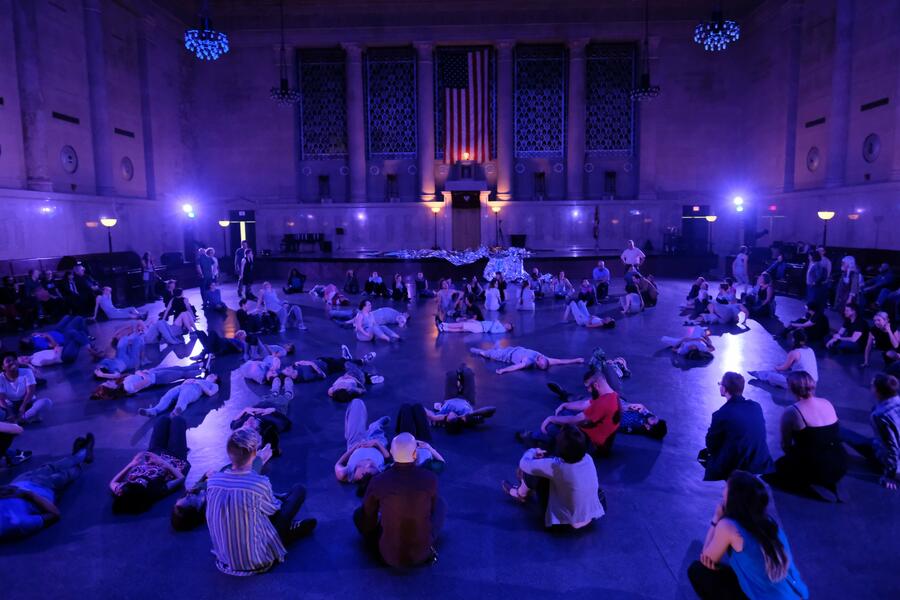 UtopiaThe audience and ensemble end the show lying on the floor, looking up to enjoy a light show and listening to the soundtrack.
UtopiaThe audience and ensemble end the show lying on the floor, looking up to enjoy a light show and listening to the soundtrack. -
MarchingThe sound of pounding drums accompanied the ensemble, marching back into the space fully masked.
-
Lines
In this scene, the cast emerged one-by-one to enter a stark beam of light. As they proceed, they remove their colorful clothing to reveal the same grey costume beneath.
H.T. Darling's Incredible Musaeum Presents: The Treasures of New Galapagos, Astonishing Acquisitions from the Perisphere (2017)
Content devised in collaboration with the ensemble: Josh Aterovis, Francisco Benavides, David Brasington, Emily Hall, Martha Robichaud, Trustina Sabah, Lisi Stoessel, Sarah Olmsted Thomas, Alex Vernon.
For "Musaeum," Submersive formed a team of over twenty artists to transform all four floors of The Peale Center into a museaum of artifacts from another planet. Every show night was the "Grand Opening" of H.T. Darling's exhibiton of aquistions from the planet New Galapagos, including his prized possession: The Humanoid Specimen. The audience was greeted as members of high society and museum supporters, thus implicating them in the proceedings. Our guests had free rein to explore the space and follow any of the many narratives that played out over a two and a half hour period. The story, as told through a science fiction lens, allowed us to simultaneously celebrate our love for museums while delving unflinchingly into the dark themes of colonialization and cultural appropriation.
In term of experience design, it is always my goal to present a world that is larger than one person can percieve in a single viewing. Audience members who returned to "Musaeum" reported seeing what seemed like a completely different series of events, and even those who returned upwards of a dozen times said that they were still discovering new things. While we encouraged a very open collaborative environment, I used my roles as Producer and Co-director to keep pushing in the direction of a broadening mystery with no easy answer or resolution. In keeping the audience at the center, we place a high degree of trust for them to discover meaning for themselves rather than provide easy answers that could shut down their own meaning-making.
Press quotes:
-Baltimore City Paper
“I was blown away by the quality of the work.”
-J. Wynn Rousuck, WYPR
"Museums spend years acquiring the sort of artifacts Submersive Productions assembled for this show. It’s one thing to stage a show in a real museum – quite another to flesh out an empty one."
-Baltimore Post-Examiner
-
Excerpt from HT Darling's Incredible Musaeum (Submersive Productions, 2017)Excerpt from HT Darling's Incredible Musaeum (Submersive Productions, 2017) Role: Co-Director (Performance) with Lisi Stoessel and Susan Stroupe. "The Mastodon Scene" is the culminating scene of the two-hour devised, immersive production of HT DARLING'S INCREDIBLE MUSAEUM. This scene was the first time all the characters and audience were in the same space, where all the narrative threads came together for the end of the narrative of the two protagonists (Trustina Sabah's Aku Maxilla/The Humanoid Specimen & Sarah Olmsted Thomas' HT Darling). Although the show did not end here, the largely wordless movement sequence was very much felt as the "climax" of the show. This scene was also the culmination of months of collaborative ensemble work; it was collaboratively choreographed, using content and research from many different parts of our process.
-
The Dax and The Net RoomTwo examples of sound and projections used to create fantastical environments. The spinning portal and drifting starscape transformed an otherwise empty room into a gateway to other worlds. In the "Net Room" hanging fabric and a cone-shaped mosquito net form projection surfaces to create a full 3D effect. Sounds of an ominous, ever-rising Shepard tone (layered from recording sessions with the ensemble) provided rising tension even for those who spent a few moments in the room.
-
Trailer for H.T. Darling's Incredible MusaeumThis trailer gives a good sense of the movement and characters of the show.
-
ABC News Interview for H.T. Darling's Incredible MusaeumAppearing with Co-director Lisi Stoessel on ABC's local afternoon show, we do our best to explain the Musaeum experience.
-
 Percy's DeskThe desk of Dr. Percy Warner (Alex Vernon) in the downstairs back room demonstrates our production mantra that no detail is too small. We strove to make sure every performer is fully invested in the project. As a result, all participants brought in objects and ideas to flesh out the characters and world. This collaborative approach made the world especially rich and every set piece the audience encountered was intentional and fully considered.
Percy's DeskThe desk of Dr. Percy Warner (Alex Vernon) in the downstairs back room demonstrates our production mantra that no detail is too small. We strove to make sure every performer is fully invested in the project. As a result, all participants brought in objects and ideas to flesh out the characters and world. This collaborative approach made the world especially rich and every set piece the audience encountered was intentional and fully considered. -
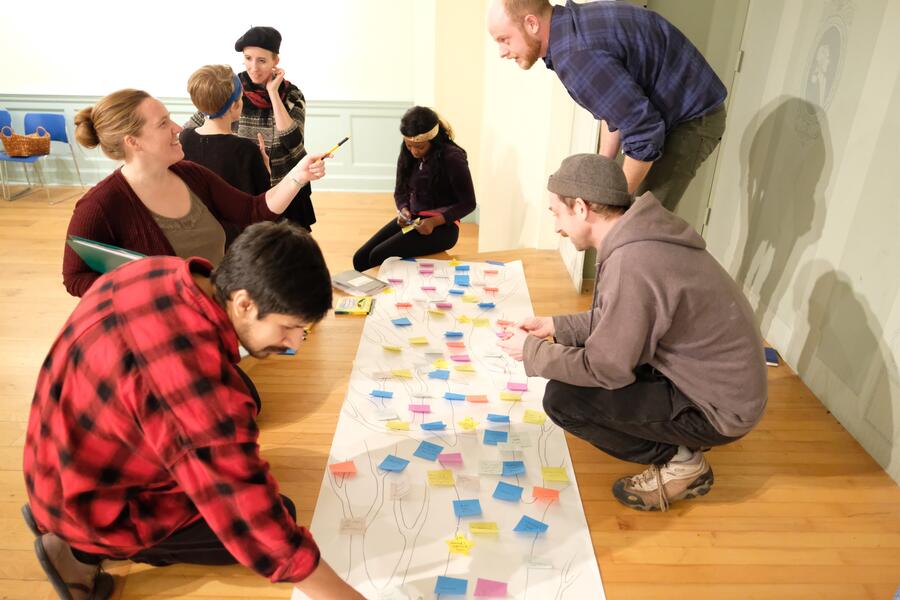 Weaving the NarrativeThe devising process unfolded in many stages, with performers working together with the directors to work towards an eventful sequence of simultaneous action. An early pass of the show seen here has us using sticky notes to track the unfolding of events and intertwined narratives over time. Later, we used the same placeholders to locate events in spaces throughout the building.
Weaving the NarrativeThe devising process unfolded in many stages, with performers working together with the directors to work towards an eventful sequence of simultaneous action. An early pass of the show seen here has us using sticky notes to track the unfolding of events and intertwined narratives over time. Later, we used the same placeholders to locate events in spaces throughout the building. -
 Grand Hall - Champagne ToastIn one of just a few scenes when most the audience gathers in a single place, H.T. Darling is introduced and we all join him in a toast "To legacy!"
Grand Hall - Champagne ToastIn one of just a few scenes when most the audience gathers in a single place, H.T. Darling is introduced and we all join him in a toast "To legacy!" -
Anachronistic DisputeThe Shopkeepers (Emily Hall and Martha Robichaud) look on as Dr. Percy Warner (Alex Vernon) and Curator Carole (David Brasington) argue over what, to Dr. Percy's memory, must be inaccurate appearances of him in a series of photographs. I created a set of historical photographs editing in Vernon's face in order to provide key factual clues to Dr. Warner's origin. We used the set in this way to provide layers of discoverable narrative throughout the piece.
-
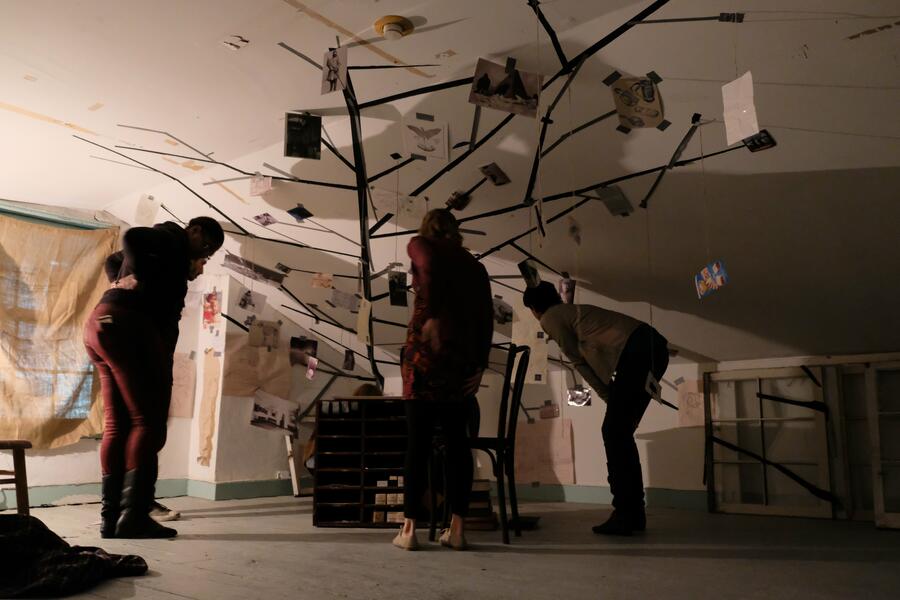 Explorable Space, Audience DiscoveryH.T. Darling's Musaeum sprawled over four floors of the Peale Center, including the 4th floor attic pictured here. Accessible at limited moments during each show, only the most curious audience members were rewarded with the additional story elements found in the room. The office and living space of the show's Grounds Keeper, the attic revealed more about his connections to the space and time beyond the building he seems tied to.
Explorable Space, Audience DiscoveryH.T. Darling's Musaeum sprawled over four floors of the Peale Center, including the 4th floor attic pictured here. Accessible at limited moments during each show, only the most curious audience members were rewarded with the additional story elements found in the room. The office and living space of the show's Grounds Keeper, the attic revealed more about his connections to the space and time beyond the building he seems tied to.
The Mesmeric Revelations! of Edgar Allan Poe (2015)
Role: Concept, Co-producer, Co-director, Composer, Sound Designer. Devised with Ensemble.
"The Mesmeric Revelations! of Edgar Allan Poe," was a many-layered immersive theater experience that ran through the Spring and Fall of 2015. The audience would freely explore the first floor of the Enoch Pratt House and observe one or more of nine overlapping stories based Poe's life and fiction. The fully devised work incorporated movement, spoken word, song, explorable sets, and private character encounters. The action was synchronized to a 2-hour continuous soundtrack that I composed in conjuction with the rest of the devising process. After a sold-out run in Spring 2015, the show was remounted with additional characters and a double cast for three more months of shows in Fall 2015. At 62 shows total, it stands as the longest-running immersive theatre piece in Baltimore history.
Press quotes:
"'The Mesmeric Revelations! of Edgar Allan Poe' proved that there are many corridors of the poet's mind yet to explore."
-Baltimore City Paper
"Surprisingly unpredictable, each performance draws a small circle of theatre goers into a world both bizarre and beautiful."
-Baltimore Post-Examiner
"Poe himself is not present, but is everywhere in the atmosphere."
-Hyperallergic
"An intensely immersive theatrical experience like no other in Baltimore, Washington, or any of the surrounding metropolitan areas, 'The Mesmeric Revelations! Of Edgar Allan Poe' is quickly becoming Baltimore’s own 'Sleep No More'".
-TheatreBloom
"'Revelations!' is like going to a haunted house run by everybody’s favorite 'cool' AP English teacher...It’s the nevermost."
-The Bad Oracle
-
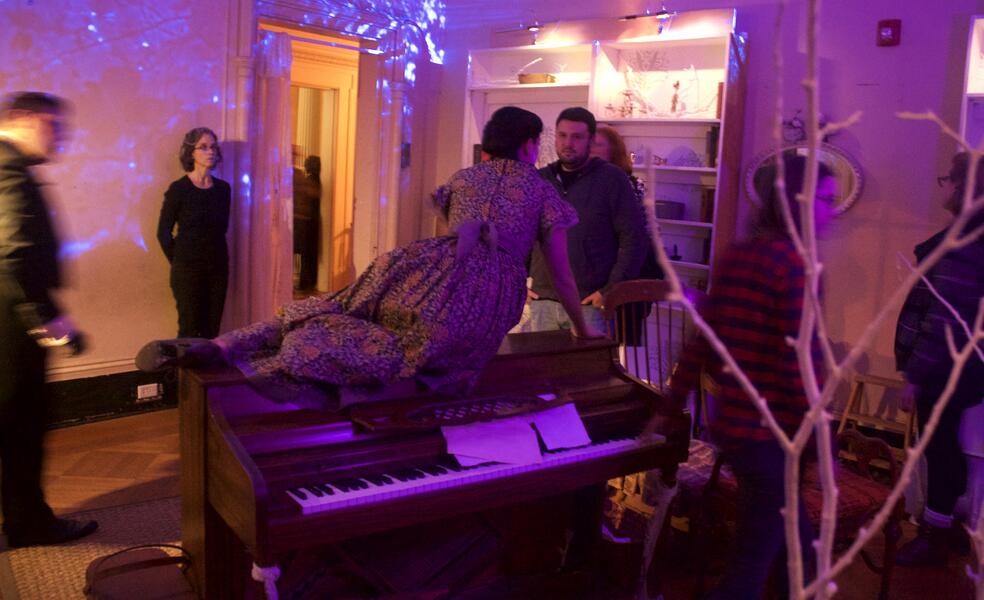 Virginia on PianoVirginia, a character inspired by Poe's wife, was portrayed by Natanya Sheva Washer (pictured) and Deirdre McAllister. For the first roughly thirty minutes, Virginia is exploring her parlor as if completely blind. She experiences a series of deaths, each of which transforms and evolves her character. The Parlor, her home base, was full of explorable objects, open-able boxes, and a collection of books hand-selected to enrich the overall atmosphere and context of the world.
Virginia on PianoVirginia, a character inspired by Poe's wife, was portrayed by Natanya Sheva Washer (pictured) and Deirdre McAllister. For the first roughly thirty minutes, Virginia is exploring her parlor as if completely blind. She experiences a series of deaths, each of which transforms and evolves her character. The Parlor, her home base, was full of explorable objects, open-able boxes, and a collection of books hand-selected to enrich the overall atmosphere and context of the world. -
 Eliza on StairsMadeline looks on as Eliza performs Ophelia's death from Hamlet (as told by Gertrude) many times over until delirious. Eliza Poe, Edgar's mother, had played Ophelia on stage and much of Eliza's text in Mesmeric Revelations was derived from the ill-fated Shakespeare character. Additional resonance comes from the detective Auguste, who investigates the bodies of two women dredged up from a river.
Eliza on StairsMadeline looks on as Eliza performs Ophelia's death from Hamlet (as told by Gertrude) many times over until delirious. Eliza Poe, Edgar's mother, had played Ophelia on stage and much of Eliza's text in Mesmeric Revelations was derived from the ill-fated Shakespeare character. Additional resonance comes from the detective Auguste, who investigates the bodies of two women dredged up from a river. -
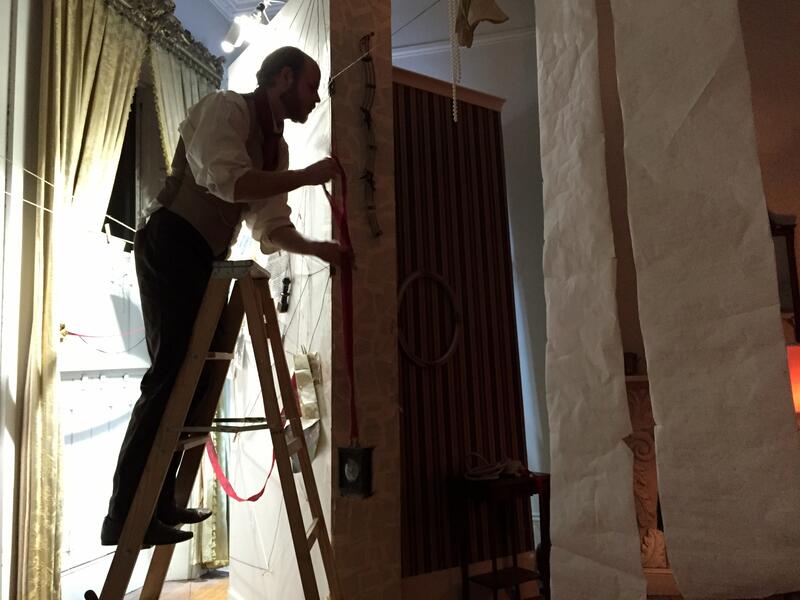 Auguste MonolougesAuguste, portrayed by Alexander Scally and David Brasington (pictured) speaks over 2500 words of text throughout the two-hour performance. Here, he is illustrating time and train schedules using available materials. The character is based on C. Auguste Dupin, the first and original detective created by Poe. Auguste in "Mesmeric Revelations" finds his use of logic to be failing him in a world that is governed by different rules.
Auguste MonolougesAuguste, portrayed by Alexander Scally and David Brasington (pictured) speaks over 2500 words of text throughout the two-hour performance. Here, he is illustrating time and train schedules using available materials. The character is based on C. Auguste Dupin, the first and original detective created by Poe. Auguste in "Mesmeric Revelations" finds his use of logic to be failing him in a world that is governed by different rules. -
Soundtrack Excerpt from Mesmeric RevelationsA snippet of music and sound that play during the final act, when narratives unravel and the fabric of the world begins to tear. Composed and recorded by Glenn Ricci, the full soundtrack is over two hours long with a mixture of music and soundscapes scoring every moment of the action. The soundtrack was composed concurrently with the rest of the devising process, resulting in a fully integrated set of themes and cues that unified the nine separate narratives. In addition to the main soundtrack, three private areas also had independently running soundscapes.
-
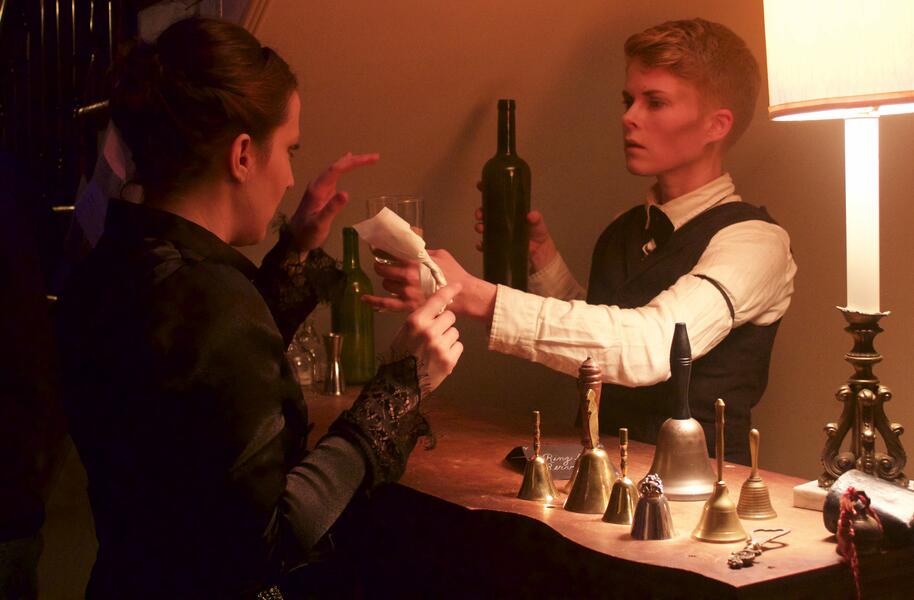 Barkeep and SarahBarkeep, played by Lisi Stoessel (pictured right) and Caitlin Bouxsein, offers a paper rose and a glass of sand to Sarah, played by Ann Turiano (pictured left) and Shannon Graham. The character of Sarah was inspired by Sarah Helen Whitman, a poet, spiritualist, and fiancee of Poe's. Barkeep, an androgynous amalgam of Poe's characters, slowly discovers what and who they are over the course of the performance.
Barkeep and SarahBarkeep, played by Lisi Stoessel (pictured right) and Caitlin Bouxsein, offers a paper rose and a glass of sand to Sarah, played by Ann Turiano (pictured left) and Shannon Graham. The character of Sarah was inspired by Sarah Helen Whitman, a poet, spiritualist, and fiancee of Poe's. Barkeep, an androgynous amalgam of Poe's characters, slowly discovers what and who they are over the course of the performance. -
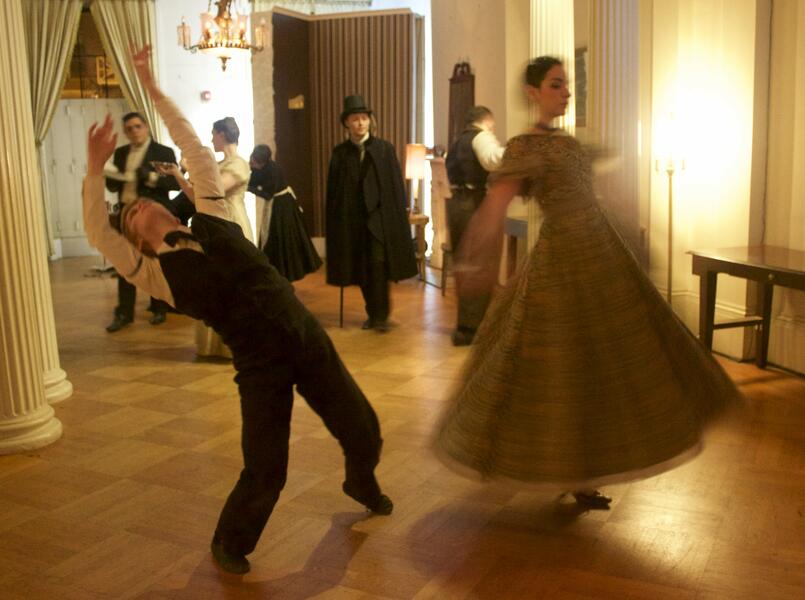 Ballroom SceneAll characters (and most of the audience) converge for the first time during a ballroom scene at the end of Act I. As Virginia (right, played by Natanya Sheva Washer) enters, time begins to warp.
Ballroom SceneAll characters (and most of the audience) converge for the first time during a ballroom scene at the end of Act I. As Virginia (right, played by Natanya Sheva Washer) enters, time begins to warp. -
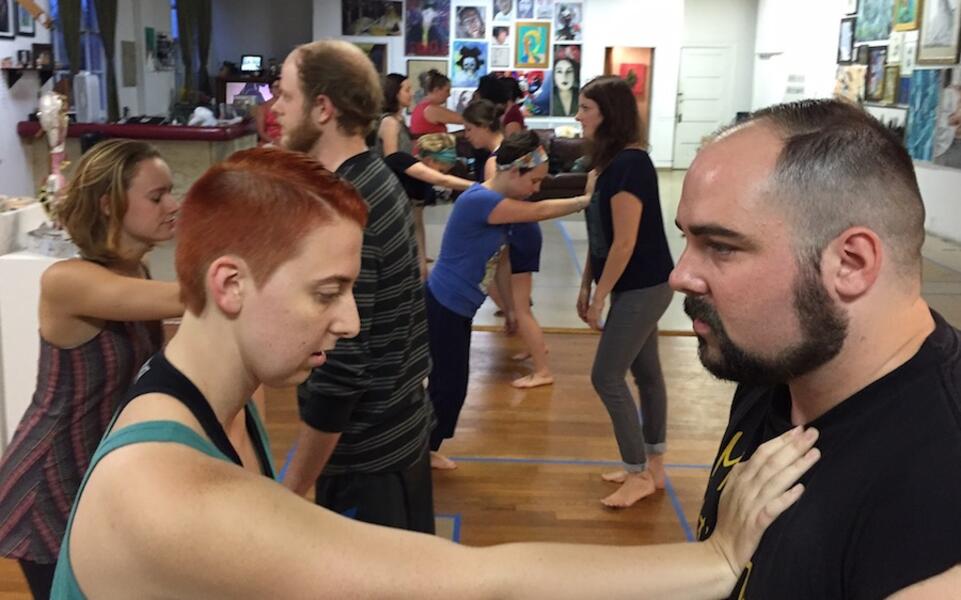 WorkshoppingThe Spring Edition of "Mesmeric Revelations" was devised over a nine-month period, starting in July 2014. The six original performers worked with the creative team to develop material off-site until early 2015 when they began assembling scenes in the Enoch Pratt House. Props, sounds, and sets were developed concurrently. For the Fall Edition, ten additional performers joined the original group and the double-cast of 16 spent ten more weeks learning and re-devising the piece for a more complex Fall Edition of the experience.
WorkshoppingThe Spring Edition of "Mesmeric Revelations" was devised over a nine-month period, starting in July 2014. The six original performers worked with the creative team to develop material off-site until early 2015 when they began assembling scenes in the Enoch Pratt House. Props, sounds, and sets were developed concurrently. For the Fall Edition, ten additional performers joined the original group and the double-cast of 16 spent ten more weeks learning and re-devising the piece for a more complex Fall Edition of the experience. -
The Mesmeric Revelations! of Edgar Allan Poe from Submersive Productions
Role: Concept, Co-producer, Co-director, Composer, Sound Designer. Devised with Ensemble. A view into the immersive experience as well as an example of my video and sound work (directed and edited by Glenn Ricci). Video footage for this trailer was shot during a single performance of "Mesmeric Revelations" with audience members wearing body-mounted cameras. All sound and music heard was also a part of the live performance.
-
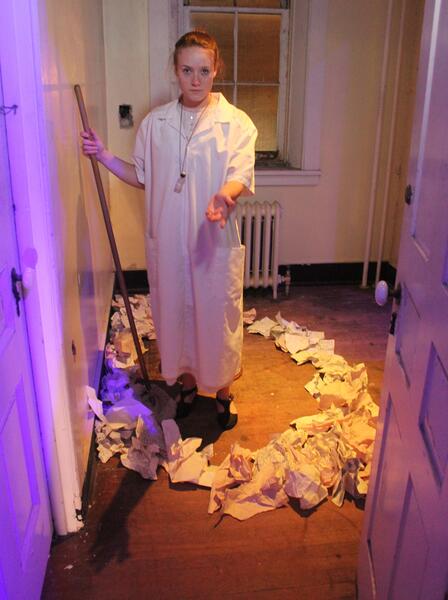 The Stranger's Room
The Stranger's RoomAdded to the Fall Remount: A handful of guests each evening are invited to climb the servants' stairs and enter the private room where The Stranger resides. A private show-within-the-show, The Stranger was a secret and personal mediation on history and loss. The Stranger would mop scraps of paper on the floor into a circle. Each were replicas of historical documents related to the stories told by The Stranger. After channeling a first-person account ending with the the loss of a loved one, the guest would be invited to write down the name of someone they had lost. Many found their encounter with The Stranger deeply moving.
-
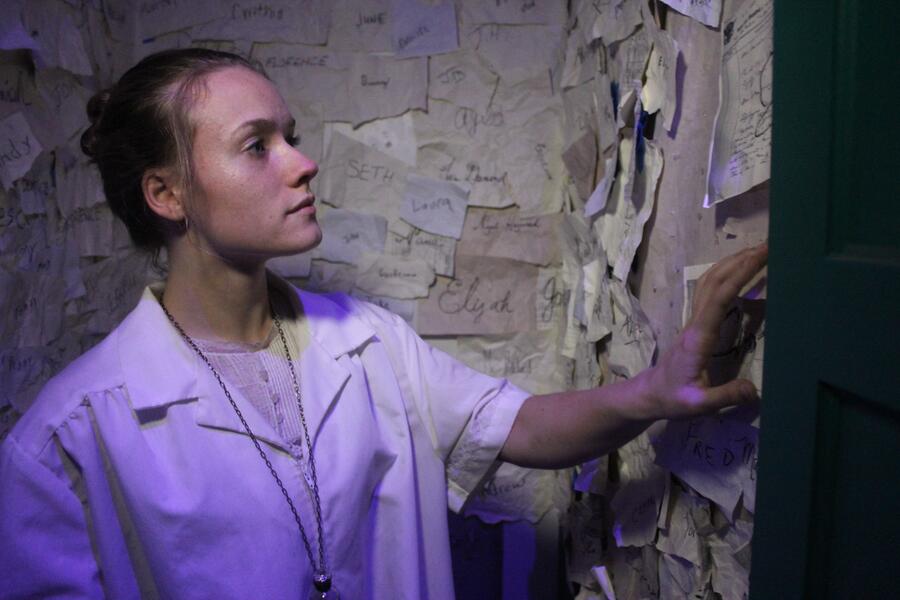 The Stranger: The Wall of Names
The Stranger: The Wall of NamesPart of The Stranger: a secreat and personal show-within-a-show added for the Fall Edition. After channeling a first-person account ending with the the loss of a loved one, the guest would be invited to write down the name of someone they had lost. They would then be led to a separate room where the guest added their name to a wall containing many others. Many months after the closing of Mesmeric Revelations, the cast gathered to complete the ritual. Each name left on the Stranger's wall by audience members was read aloud and ceremonially burned. It was yet another reminder that we had created something that had extended well beyond any single performance. Performer: Martha Robichaud.
A Horse by the Tail in the Night (2018)
Written, conceived and performed by Francisco Benavides and Lisi Stoessel; with Josh Aterovis, Ursula Marcum, Glenn Ricci, and Susan Stroupe.
Three eight-hour performances in November and December 2018.
Billed as "Episode Six" of The Institute of Visionary History and the Archives of the Deep Now, "A Horse" took a radical departure in the form of an eight-hour continuous performance. Because the performance was roughly half-improvised and eight hours in length, I decided to generate all sounds and music live while watching the performance on screen in a separate room. After their stay (between one and eight hours) in the main performance space, the audience could cross over into my area to experience the performance a whole other "behind the curtain" sort of mode.
Using a combination of audio software tools and live instruments, I wove a soundscape that lept between Renaissance stylings, more recent western film scores, and futuristic sonic journeys. As the audience came to slowly realize that the sound was responding to the action, they began to percieve it as a third character of sorts.
-
Chess and Bombers from A Horse by the Tail in the NightOne scene from "A Horse by the Tail in the Night" with Lisi Stoessel and Francisco Benavides. An example of my lighting, projections, and live sound applied to create different moods, places, and times within the same room. Giving sharp relief to the violin textures, the sound of a western-style guitar and lighting shift to a nighttime atmosphere announced the transition to one of a series of episodes set in a different place and time.
-
Live Sound Design Station for "A Horse by the Tail in the Night," an 8-hour durational performance.Featured in American Theatre Magazine's special Spotlight on Sound Design: "6 Productions That Pushed the Sonic Envelope" (July/August 2019). Because the 8-hour performance was largely improvised, I needed to perform the sound accompaniment live. My live sound design setup for "A Horse by the Tail in the Night" consisted of one computer (running Ableton Live), an iPad (running two sound manipulation programs), and a DJ mixer letting me cross fade between the two. My guitar ran live through the computer, with other live instruments (theremin, microphones, and washtub bass) sent directly to the mixer. This setup left me nimble enough to switch quickly between abstract sounds of antiquity and live guitar backed up by drum beats and other software-based instruments.
-
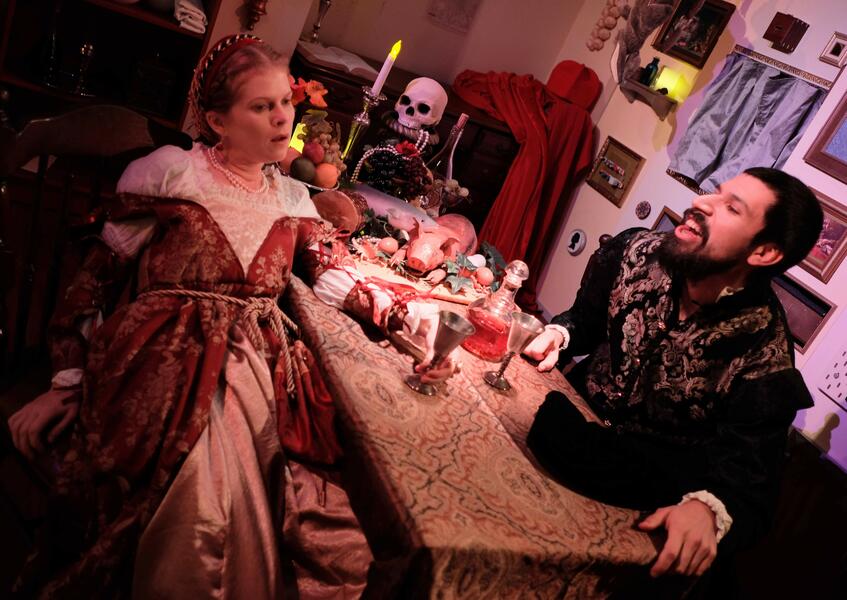 Barone and The ViscontessaLisi Stoessel and Francisco Benavides as The Viscontessa and Barone, transforming into other characters as needed over the course of the eight-hour performance.
Barone and The ViscontessaLisi Stoessel and Francisco Benavides as The Viscontessa and Barone, transforming into other characters as needed over the course of the eight-hour performance. -
 Guitar and ThereminIn addition to guitar, a theremin proved expressive enough to punctuate some of the more bizarre scenes.
Guitar and ThereminIn addition to guitar, a theremin proved expressive enough to punctuate some of the more bizarre scenes. -
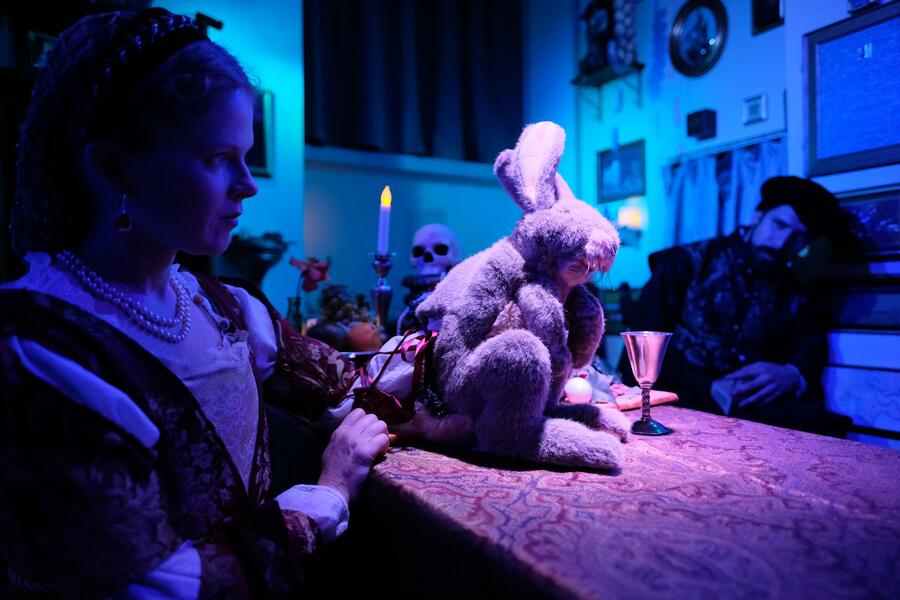 Midnight LightingThe overall lighting scheme for The Institute of the Visionary History was surprisingly adaptable for the many moods of "A Horse by the Tail..." This shift to a nighttime feel was used for a set of stories involving the travel of a coffin that became a thread throughout all eight hours.
Midnight LightingThe overall lighting scheme for The Institute of the Visionary History was surprisingly adaptable for the many moods of "A Horse by the Tail..." This shift to a nighttime feel was used for a set of stories involving the travel of a coffin that became a thread throughout all eight hours. -
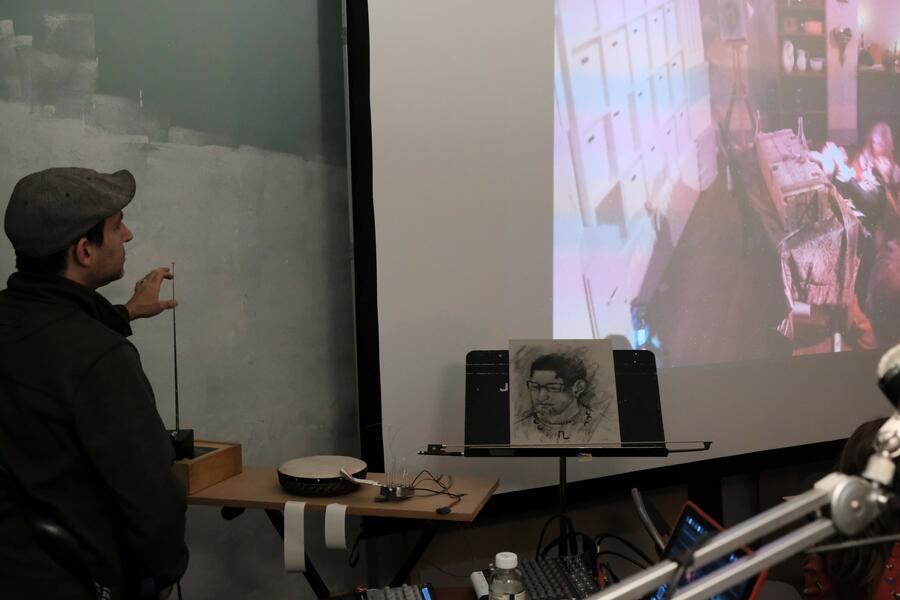 Another View on the PerformanceA view of the performance was projected live in a separate room I shared with audience members after they left the main space. Here, I was able to watch and play along to the performance in real time as it unfolded over the course of all eight hours. I created this setup to extend the audience experience, giving them a peek "behind the curtain" and allowing them to continue to view the performance for as long as they wished.
Another View on the PerformanceA view of the performance was projected live in a separate room I shared with audience members after they left the main space. Here, I was able to watch and play along to the performance in real time as it unfolded over the course of all eight hours. I created this setup to extend the audience experience, giving them a peek "behind the curtain" and allowing them to continue to view the performance for as long as they wished. -
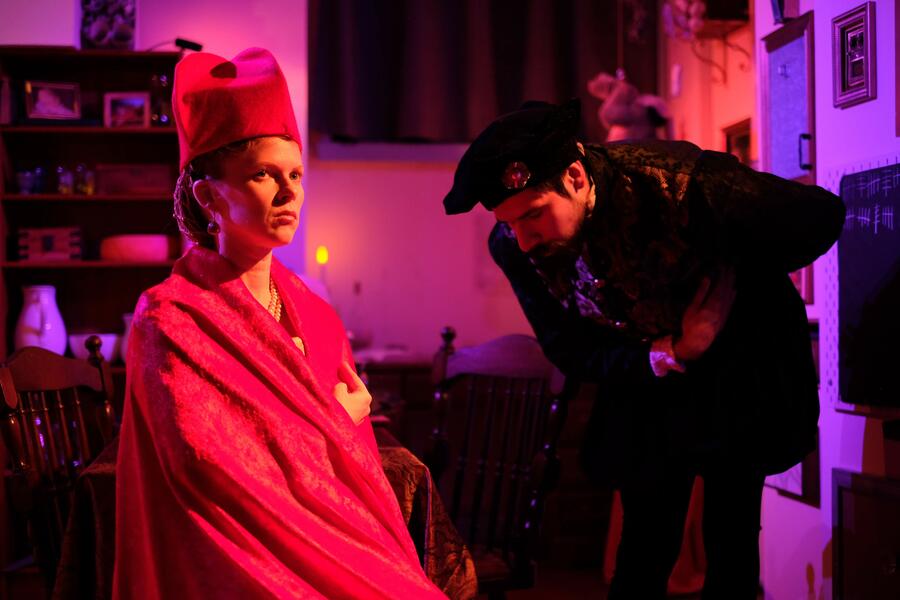 The CardinaleA reoccurring tale of a female Cardinal called for stark lighting fitting of Rennassaince portraiture.
The CardinaleA reoccurring tale of a female Cardinal called for stark lighting fitting of Rennassaince portraiture.
Plunge (2017) | BATS! (2018)
Plunge: An Interactive Storytelling Lab (2017)
Roles: Concept, production, sound, lighting, design and content devised with ensemble.
Plunge included five stories and installations exploring the theme of "the other." Five performers (“tellers”) were paired with five installation artists (“makers”) to present unique immersive environments and one-to-one experiences for audience members during one full weekend of performances. Inspired by how our character in The Stranger had connected with audience members in an individual and personal way, Plunge was created to further explore the potential of one-to-one performance as well as work with a new and diverse group of artists.
To create Plunge, we designed and conducted a series of workshops focused on storytelling and intimate performance, with both makers and tellers participating together in all stages of learning and creation. Part-way through the process, makers and tellers were paired up to jointly develop their experience. The result was an eclectic set of small worlds each containing short performance, all joined by a “Hub” space where the audience could pause to collect their thoughts and engage in a number of activities that reinforced the main theme.
BATS! (2018)
Roles: Production, sound, lighting, projections, core creative/devising team.
Run: March 15 -31 2018
Words and performance by Michele Minnick, devised by Minnick, Caitlin Bouxsein, Ursula Marcum, Glenn Ricci, and Jess Rassp.
"BATS!" was Submersive's first newly devised solo work, performed in the then-dormant Marquee Lounge at The Creative Alliance. Through conversation, interaction, stories, sound, original illustrations by Baltimore artist Chelsea Demitras, and some accordion songs, "BATS!" explored the tricky landscape of reason and insanity.
The performance used all aspects of the room as the audience, while seated, were invovled to a high degree. Using the fiery mural wall behind the bar as a projection surface, I wove light, sound, and motion into the experience as the rest of the action was being devised.
-
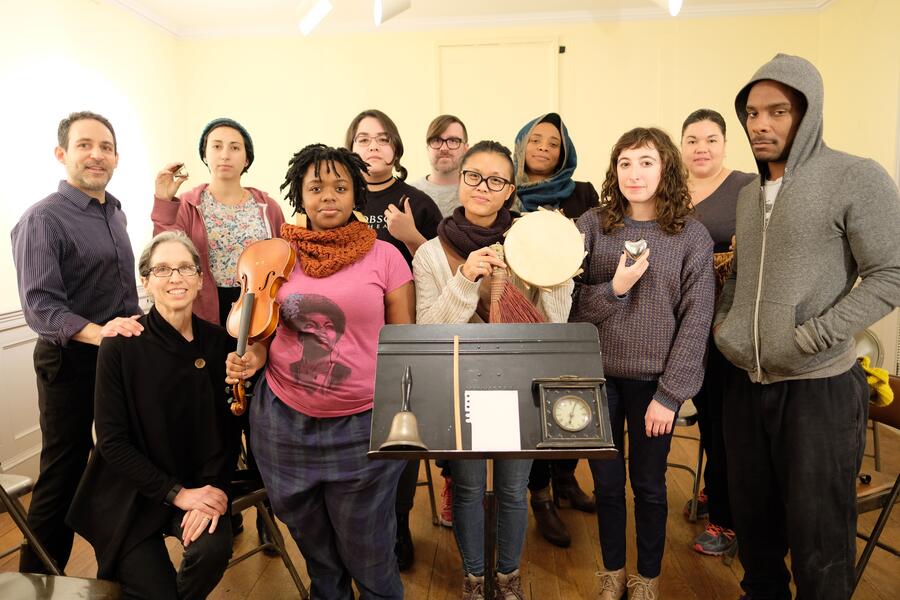 Team PlungeThe Makers and Tellers of Plunge: Tellers: Alisa Lashana Brock, Cori Dioquino, Abby Becker, Ashley Minner, Mike Smith and Kevin Griffin Moreno. Makers: Marie Claire Macadar, Samantha Callanta, Ada Pinkston, Ursula Marcum, and Ashley Minner, Glenn Ricci, and Josh Aterovis.
Team PlungeThe Makers and Tellers of Plunge: Tellers: Alisa Lashana Brock, Cori Dioquino, Abby Becker, Ashley Minner, Mike Smith and Kevin Griffin Moreno. Makers: Marie Claire Macadar, Samantha Callanta, Ada Pinkston, Ursula Marcum, and Ashley Minner, Glenn Ricci, and Josh Aterovis. -
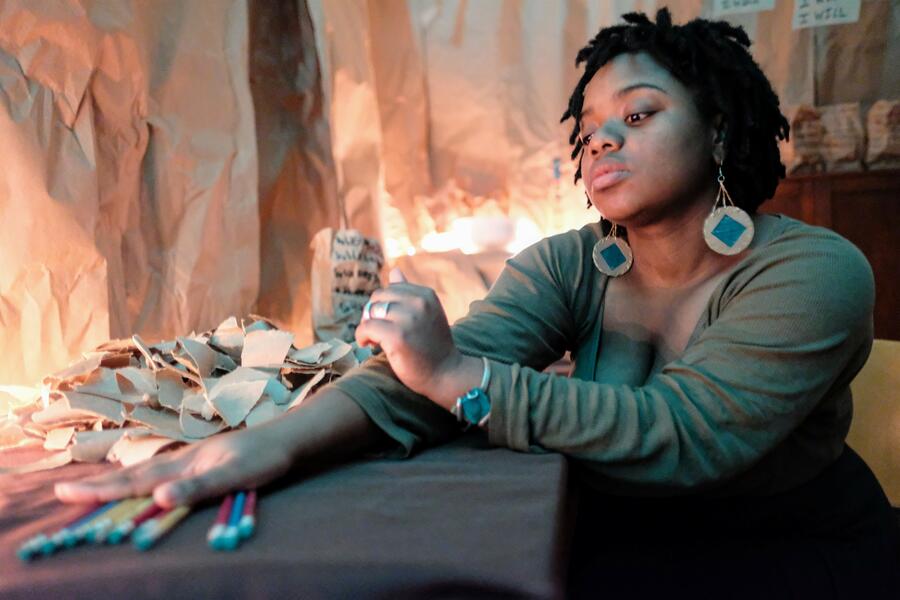 who are you? what do you want? are you sure?In a nearly wordless encounter, performer Alisa Brock guided her guests through a series of written questions and responses, ending with her visitor discovering a new direction or sense of purpose. Running between five and twenty minutes, she would take as long as needed to reach her visitor's moment of transformation. Environment designed by Ada Pinkston and Alisa Brock.
who are you? what do you want? are you sure?In a nearly wordless encounter, performer Alisa Brock guided her guests through a series of written questions and responses, ending with her visitor discovering a new direction or sense of purpose. Running between five and twenty minutes, she would take as long as needed to reach her visitor's moment of transformation. Environment designed by Ada Pinkston and Alisa Brock. -
 Chance meeting on the subwayEach space in hub was a distinctly different world. Here, the audience member would be joined by performer Cori Dioquino in a subway car (designed by Ursula Marcum) as she was traveling along across Europe. Because of the open-ended nature of the interaction, I created a soundscape that had the subway car chime for each "stop" every ninety seconds so the performer knew when to end the performance.
Chance meeting on the subwayEach space in hub was a distinctly different world. Here, the audience member would be joined by performer Cori Dioquino in a subway car (designed by Ursula Marcum) as she was traveling along across Europe. Because of the open-ended nature of the interaction, I created a soundscape that had the subway car chime for each "stop" every ninety seconds so the performer knew when to end the performance. -
The HubBetween one-to-one experiences, audience members spent time in a space we called "The Hub." Because each experience could become emotionally intense, time in The Hub gave people time to collect their thoughts. We also provided activities based around our theme of The Other which allowed audiences to respond and interact to each other over the course of the run.
-
 Good Damn Shoe ShopAnother experience had guests encountering performer Mike Smith in a shoe shop designed by Marie Claire Macadar.
Good Damn Shoe ShopAnother experience had guests encountering performer Mike Smith in a shoe shop designed by Marie Claire Macadar. -
Projections on Mural WallThe busy (and beautiful) mural wall at The Marquee Lounge provided both a challenge and opportunity as a projection surface. In the devising process we discovered that the overhead projector (center) could overpower and hide the digital projectors, creating some interesting effects, revealing images underneath others.
-
Reviving the PatientThe audience "revives" Michele by shining flashlights into mirrors at their tables.
-
Lithium is the One that I LoveA chemistry-inspired series of images are projected behind her while Michele sings about her love of lithium.
-
Working the roomProjecting a personal diary entry in an alcove on one end of the room while Michele is attempt to give a lecture on the history of madness was one way to interject the personal, underlying reality to what can be a depersonalizing system of diagnosis.
-
Mood check-inAudience involvement, such as the occasional "mood check-in," was used to reframe the story around their own personal fears and anxieties.
Music, Sound, Video (2008-2013)
Delirium Dog emerged from the need to create original music for the haunted attraction "Delirium 3-D" at The ScareHouse in Pittsburgh in 2009. I was asked to produce an original set of compositions in a "Techno Goth" style which played throughout the haunt. Having just released my first solo album as "Lunatic Dog," I thought that "Delirium Dog" would make for a fun, but temporary alter-ego. Due to the music's popularity online, I released two albums as Delirium Dog: "The ScareHouse" in 2009 and "FEVER BRAIN BATTERY" in 2011. I have done all work under that name ever since.
-
AwakenOpening track from Delirium Dog's second album, FEVER BRAIN BATTERY.
-
Delirium Dog - Absinthe Cola [Official Music Video]
Song from 2011 album by Delirium Dog, composed and recorded by Glenn Ricci. Video shot, directed, and edited by Glenn Ricci.
-
Cotton MouthFrom the 2008 album "70 West" by Lunatic Dog, composed, performed, and recorded by Glenn Ricci. "70 West" is a trip of road trip songs. On this track that closes the album, Glenn captures the feeling of an adventure coming to a close as one ponders where future roads may lead.
-
ScareHouse Rock
This interview provides an overview of Glenn's sound design work for ScareHouse in 2009. Shot and edited by Glenn Syska.
-
OutFrom the 2008 album "70 West" by Lunatic Dog, composed, performed, and recorded by Glenn Ricci. Additional vocals by Ursula Marcum.
-
Delirium Dog - "Vortex" (Official Video)
Song from 2011 album by Delirium Dog, composed and recorded by Glenn Ricci. Original motion graphics by Glenn Ricci.
-
The RitualA meditative, yet unsettling soundscape used in the entry to the ScareHouse Basement each year from 2013 to 2015.
-
T.O.L.S.From the 2009 release by Delirium Dog, T.O.L.S. uses original samples of accordion, guitar, and drums blended with synthesized instruments to create a powerful, pulsing soundscape.
-
StandingFrom the 2008 album "70 West" by Lunatic Dog, composed, performed, and recorded by Glenn Ricci.
